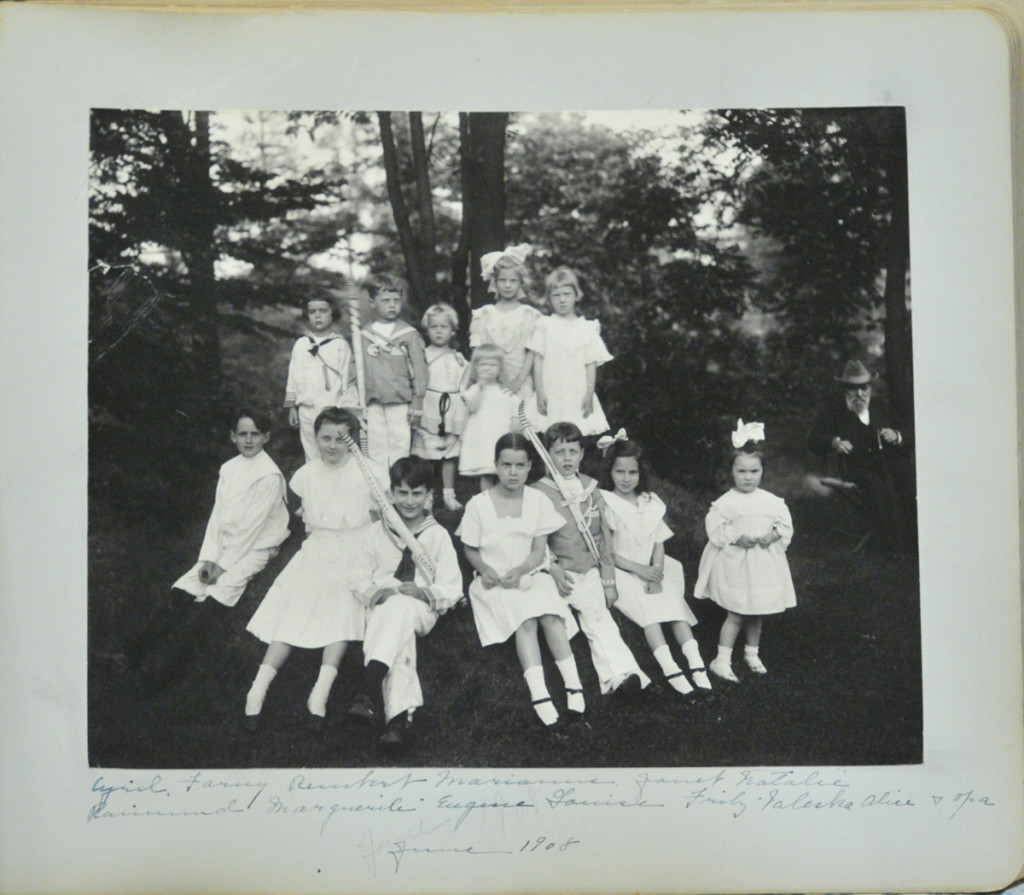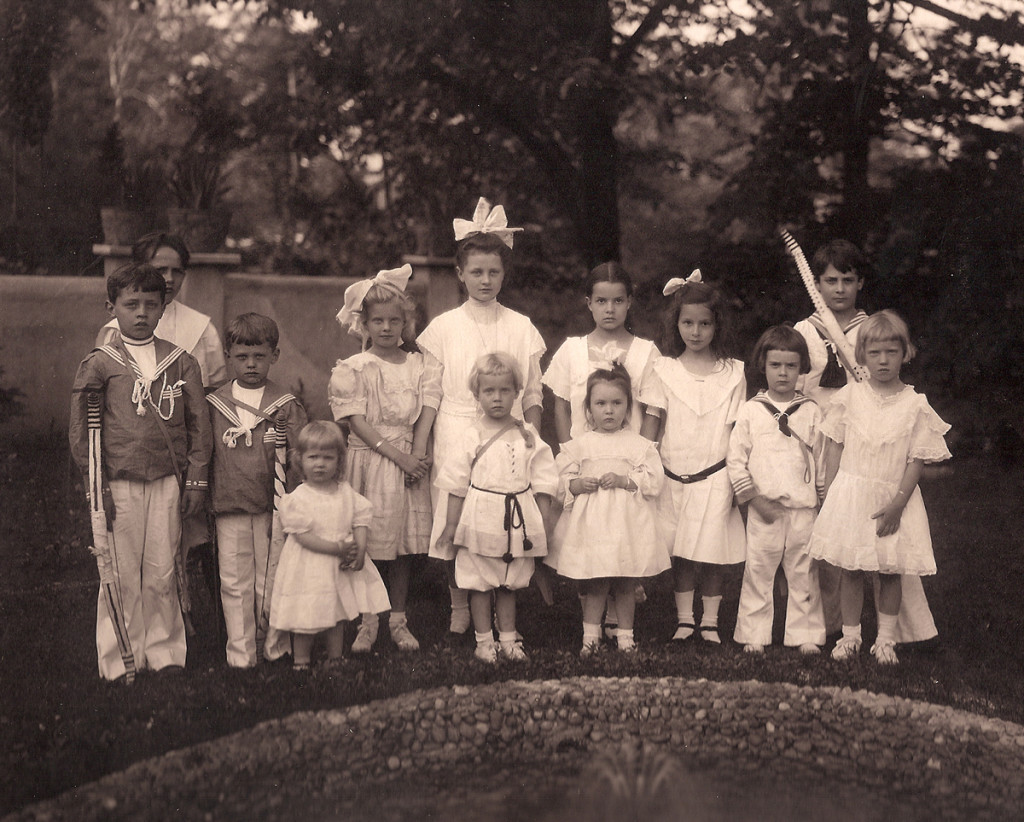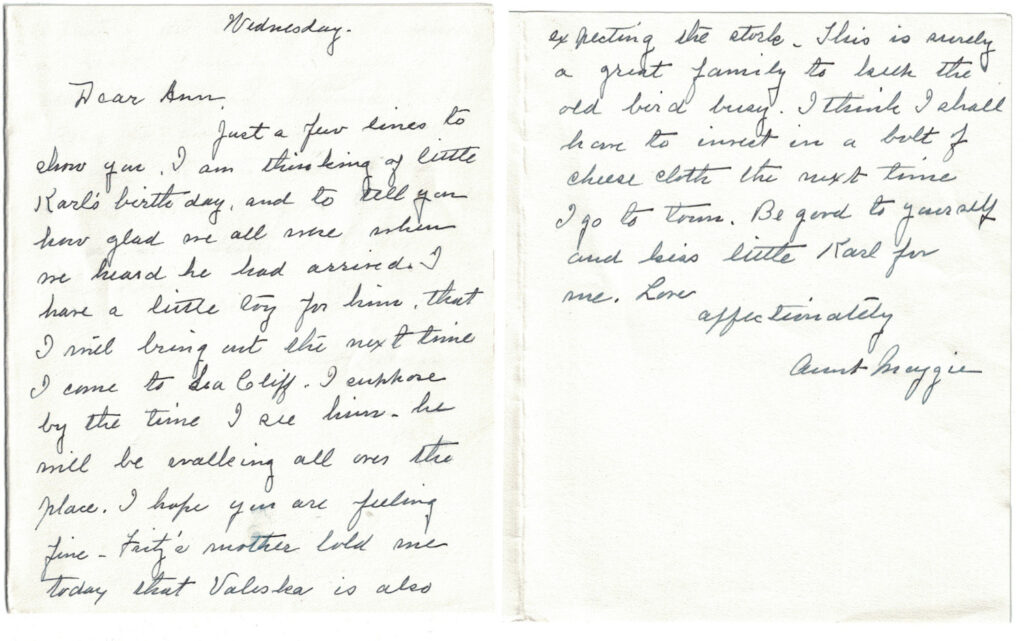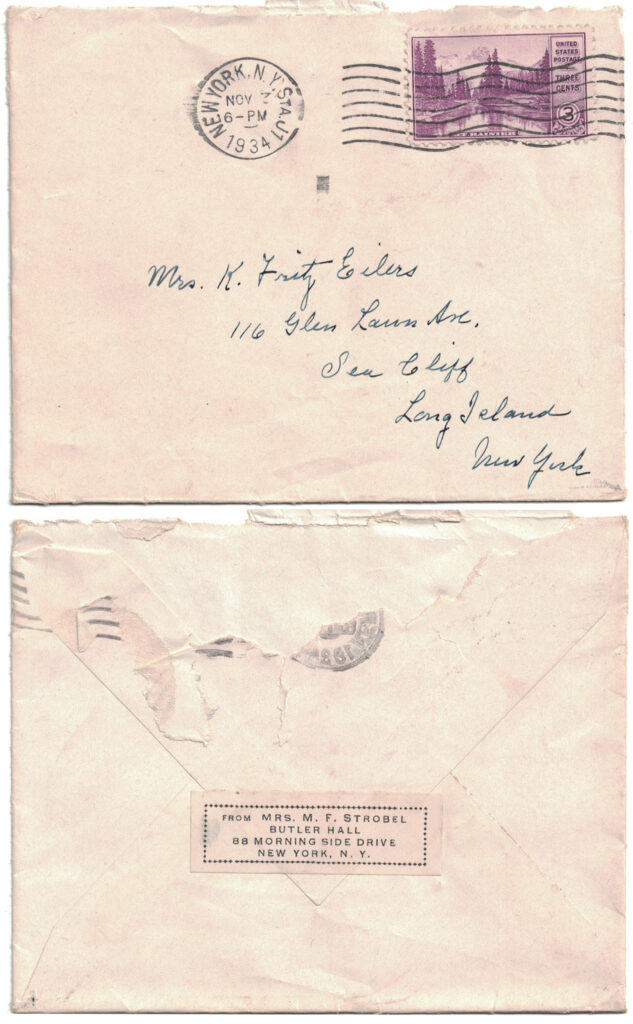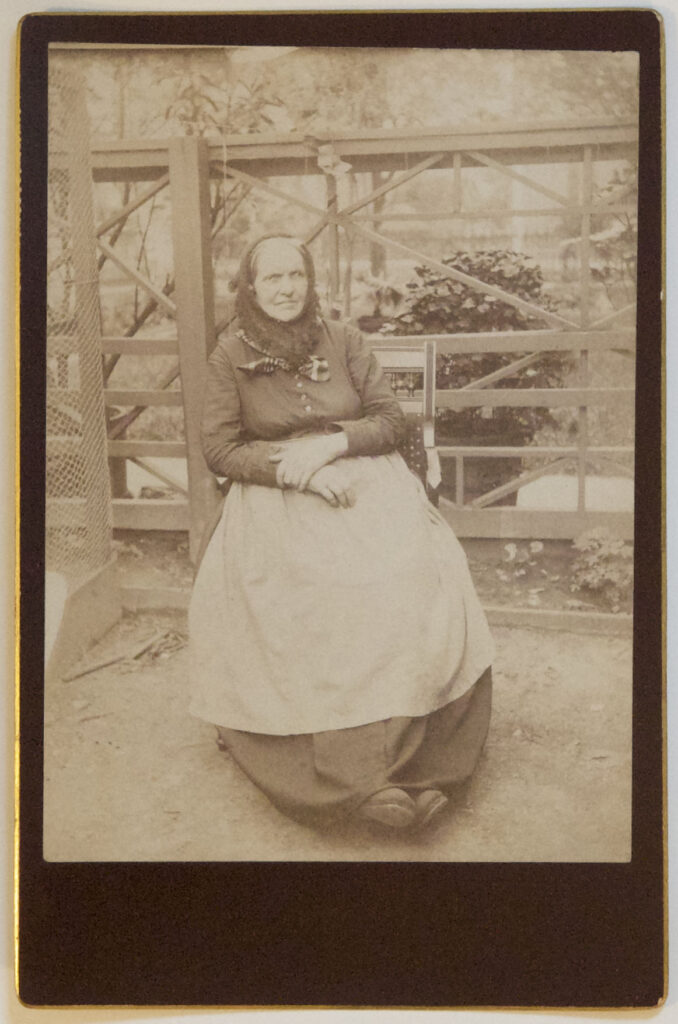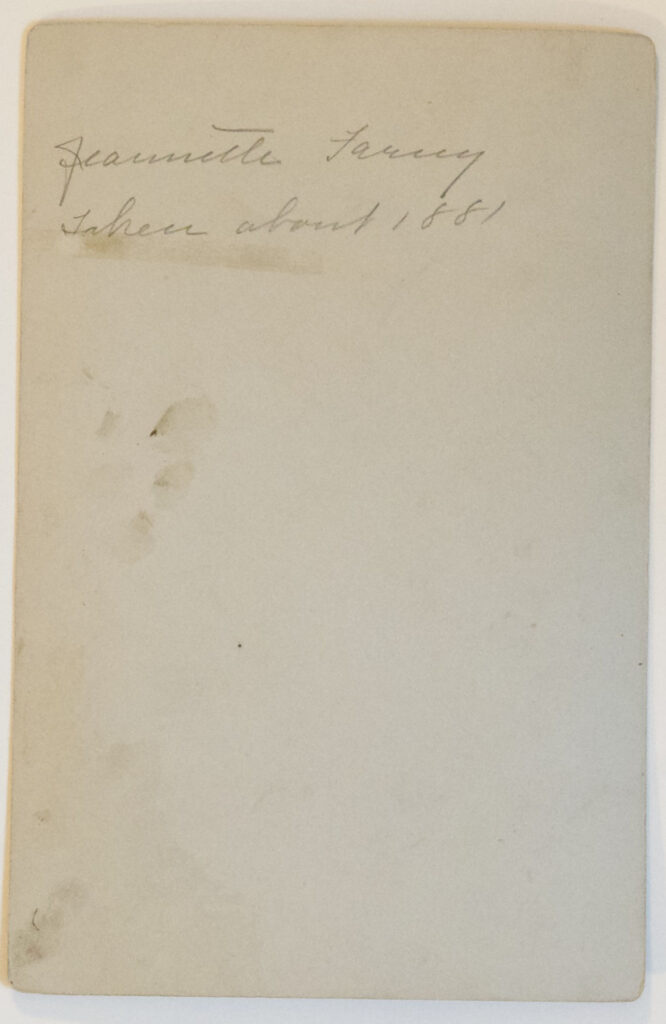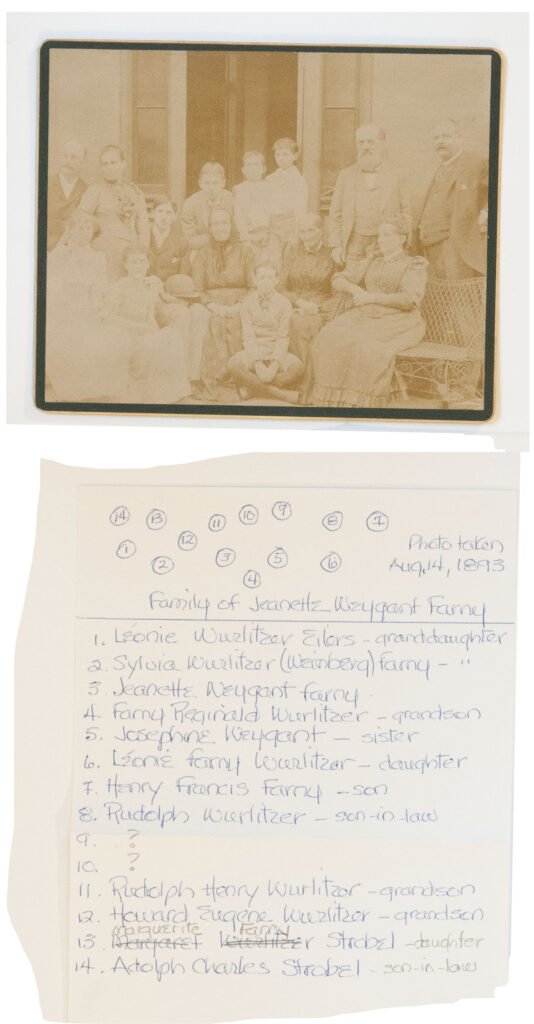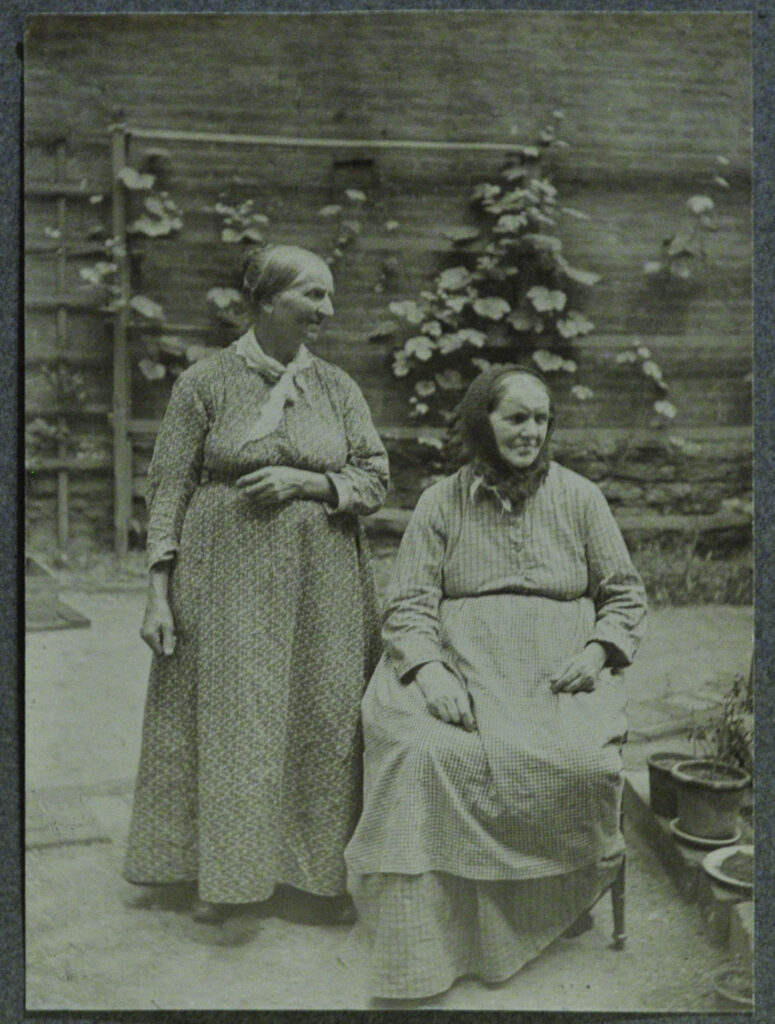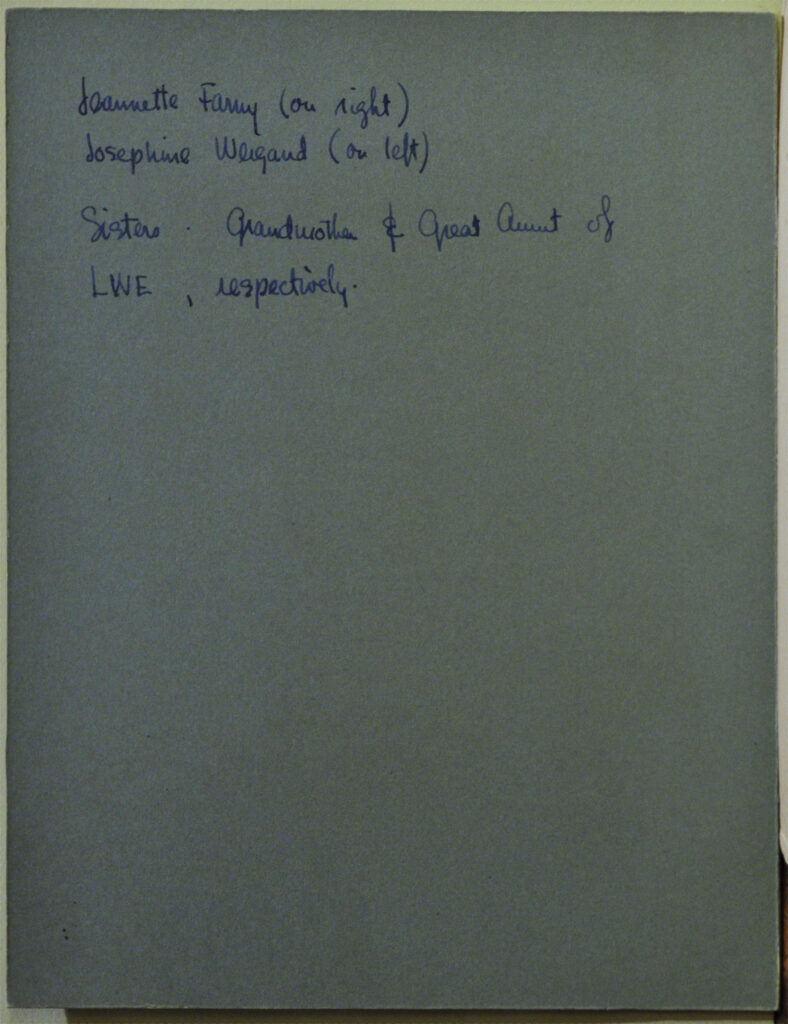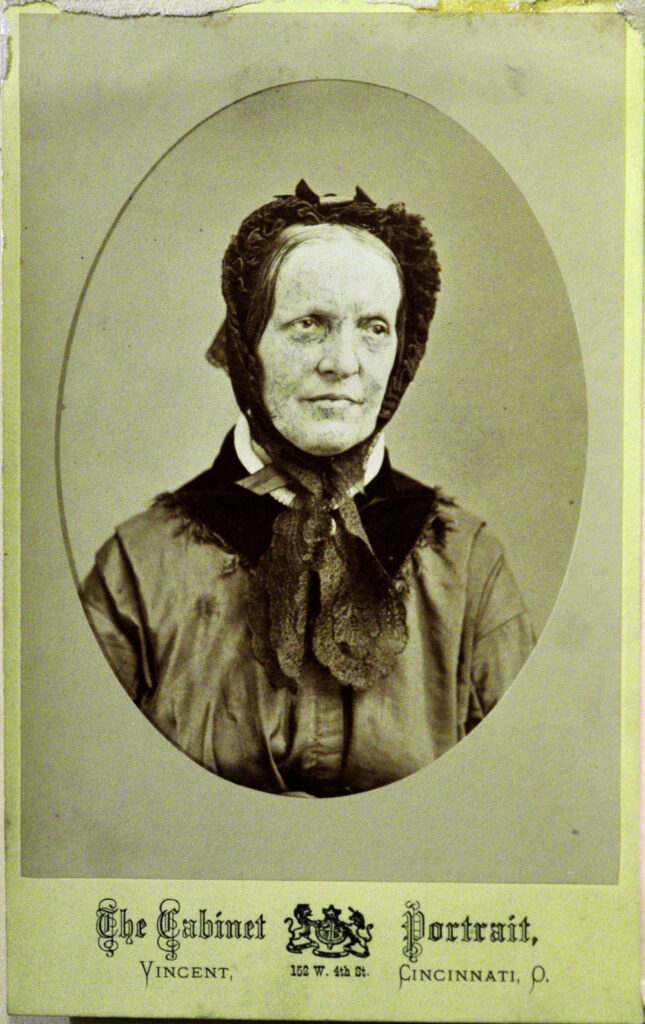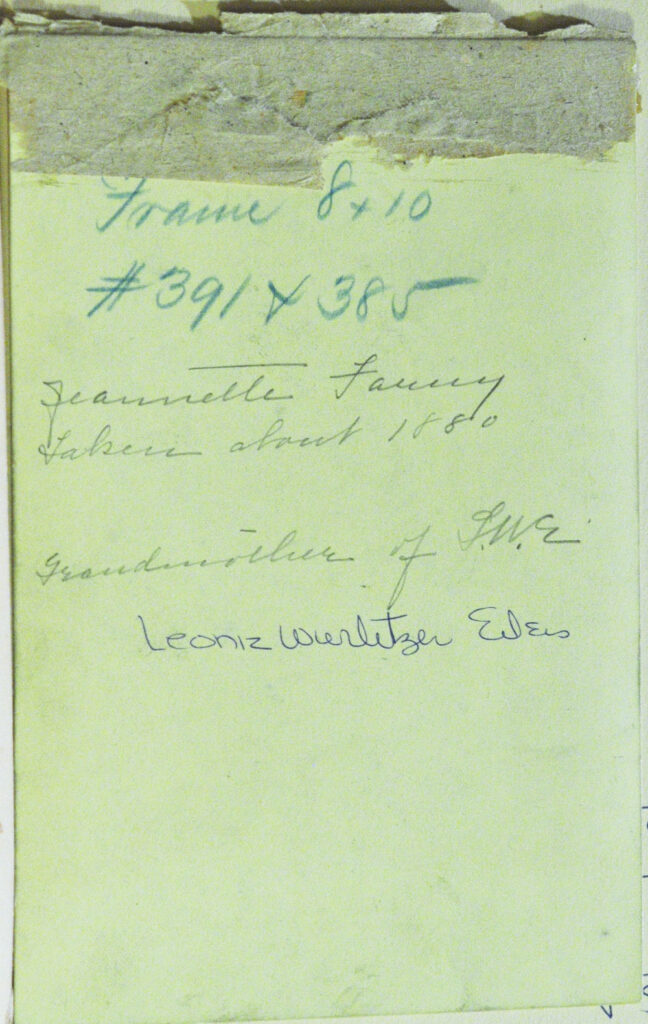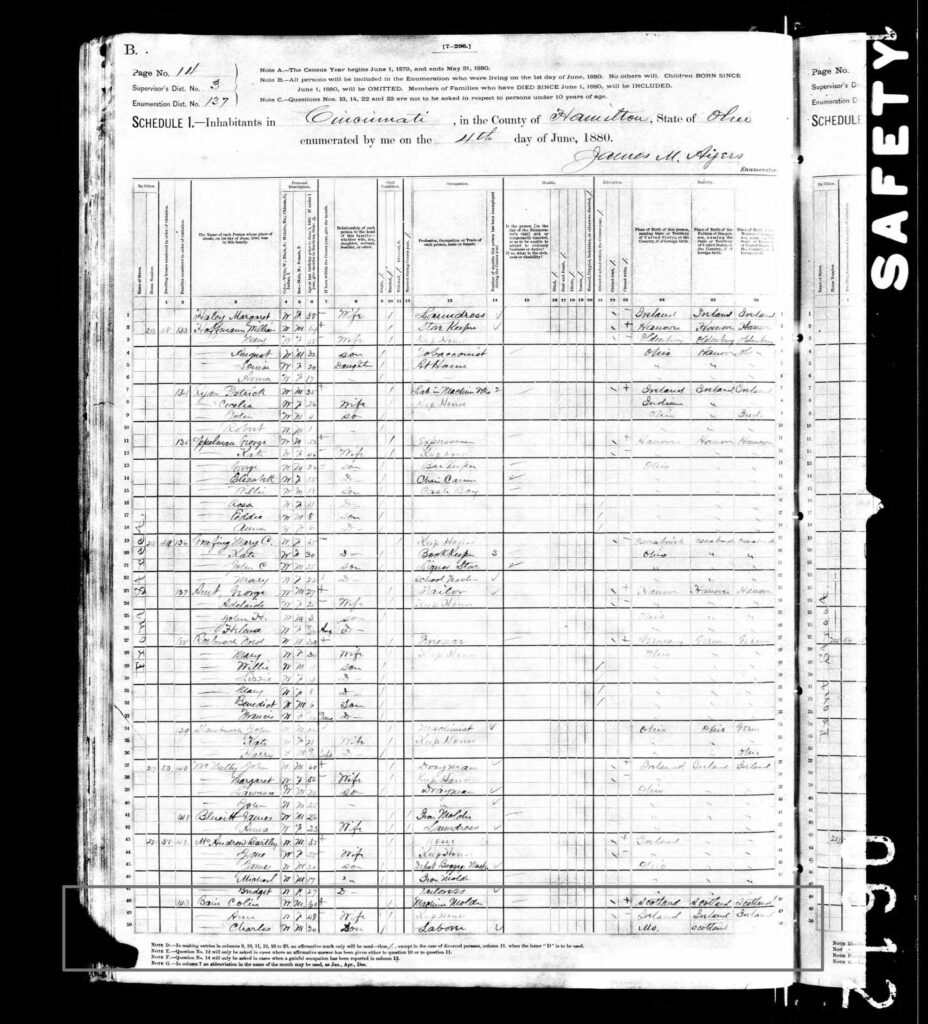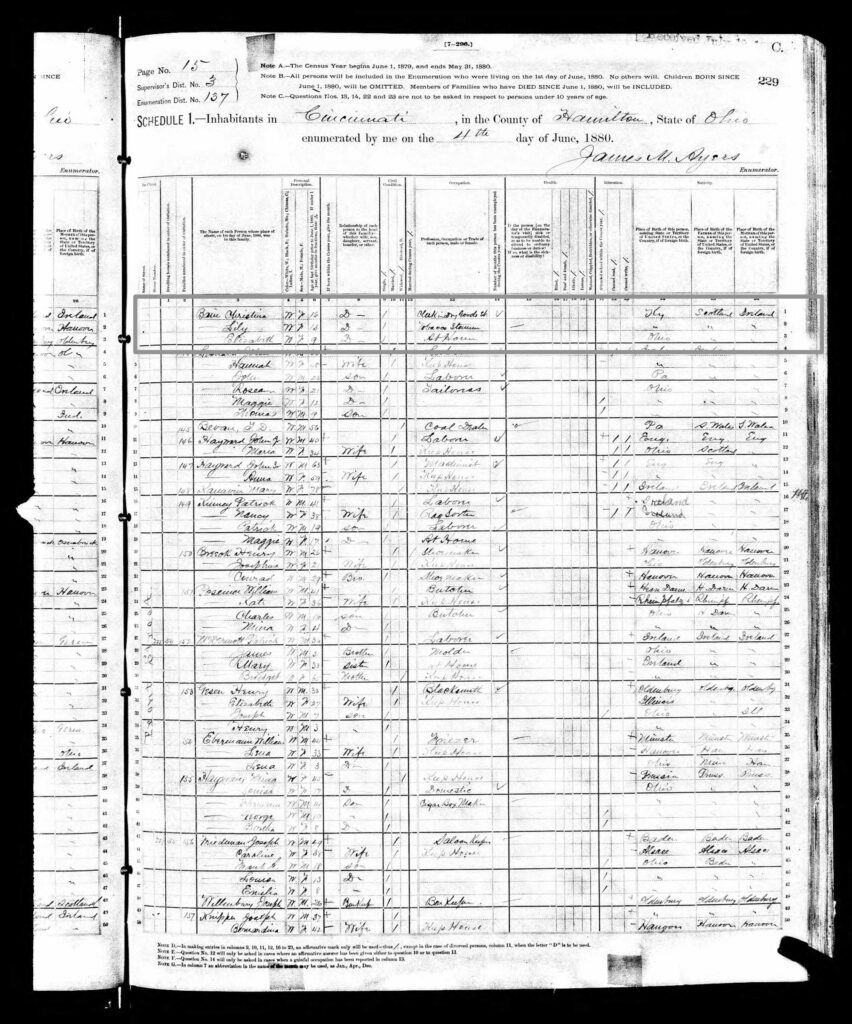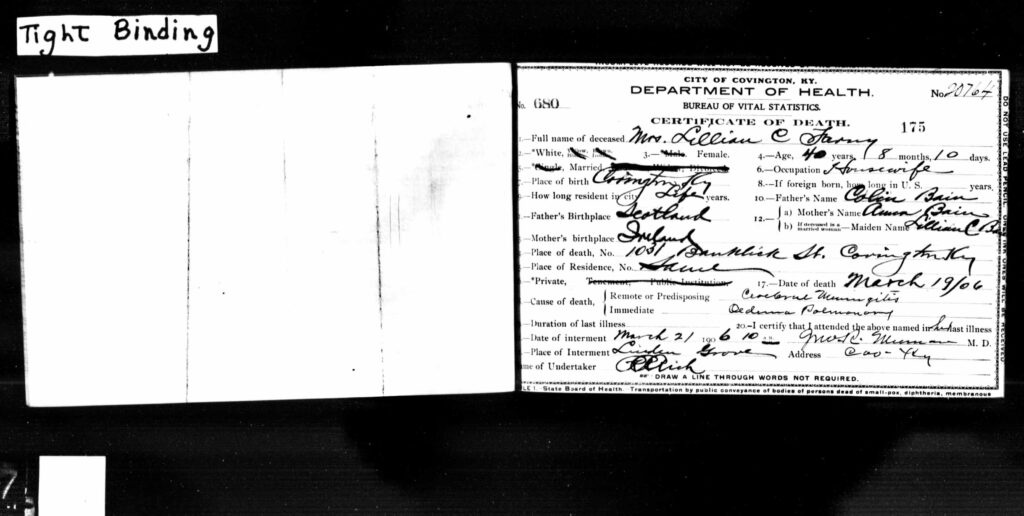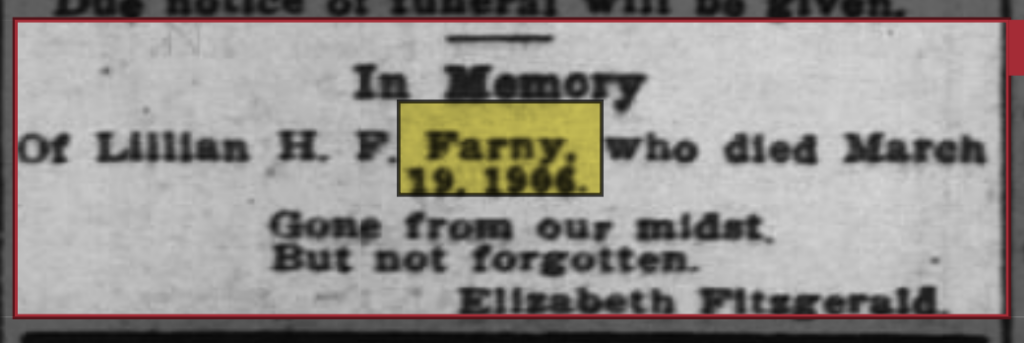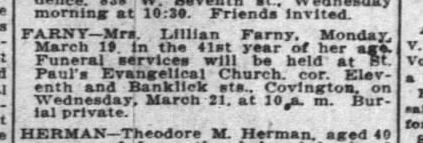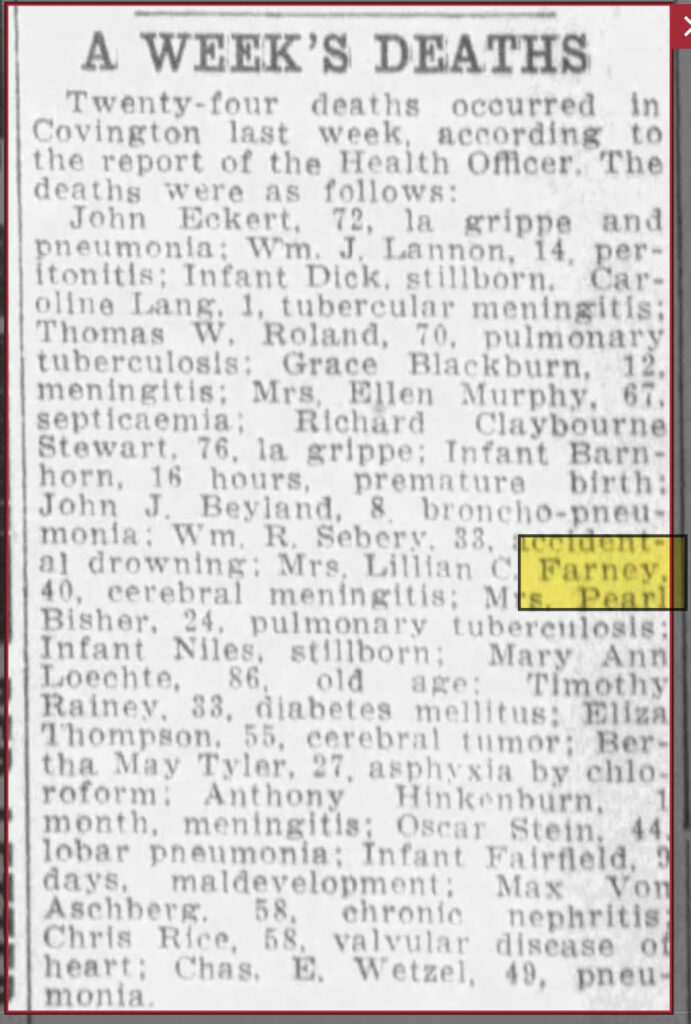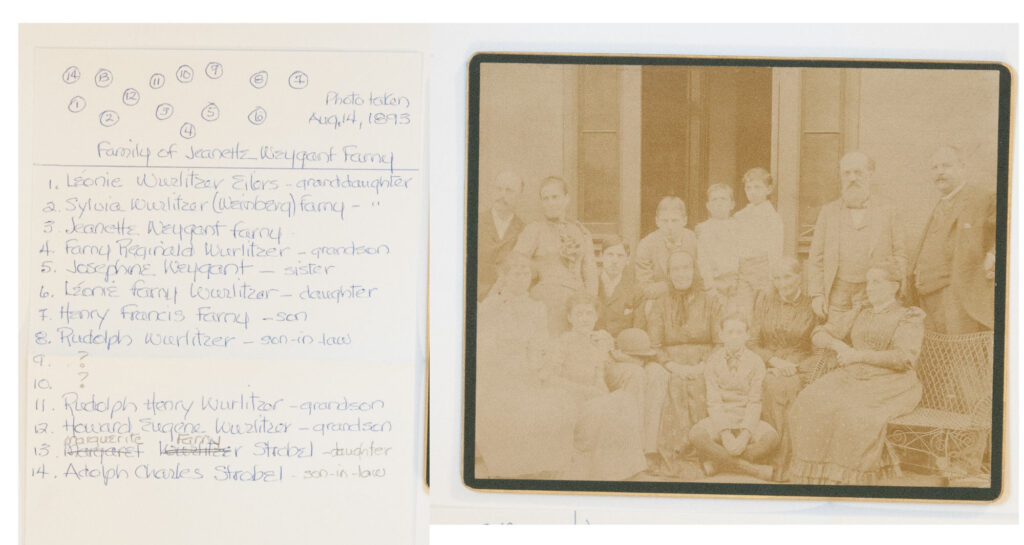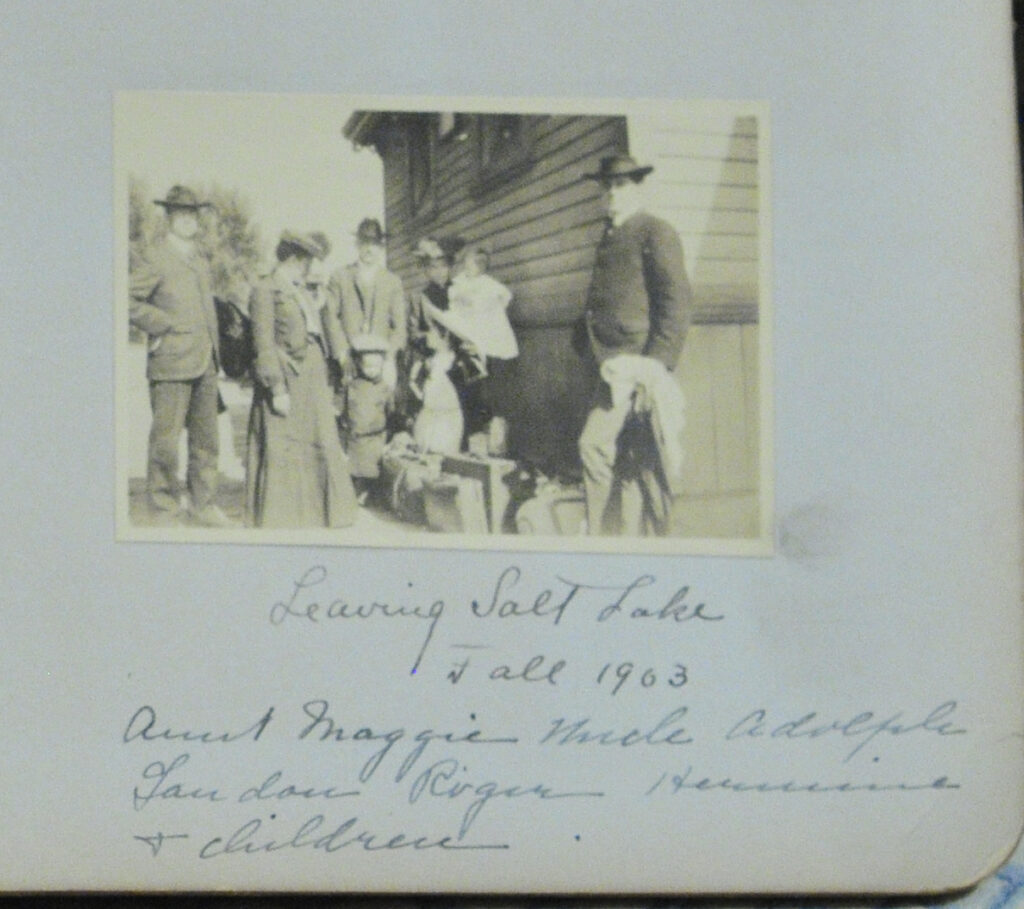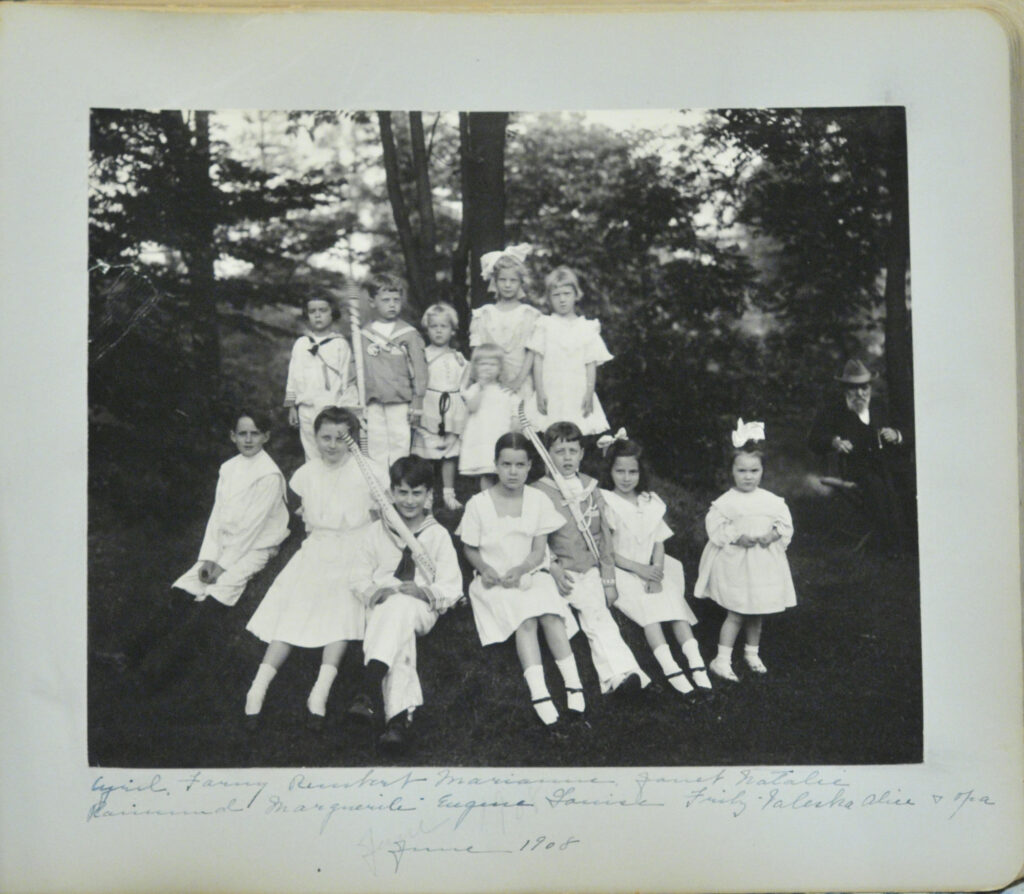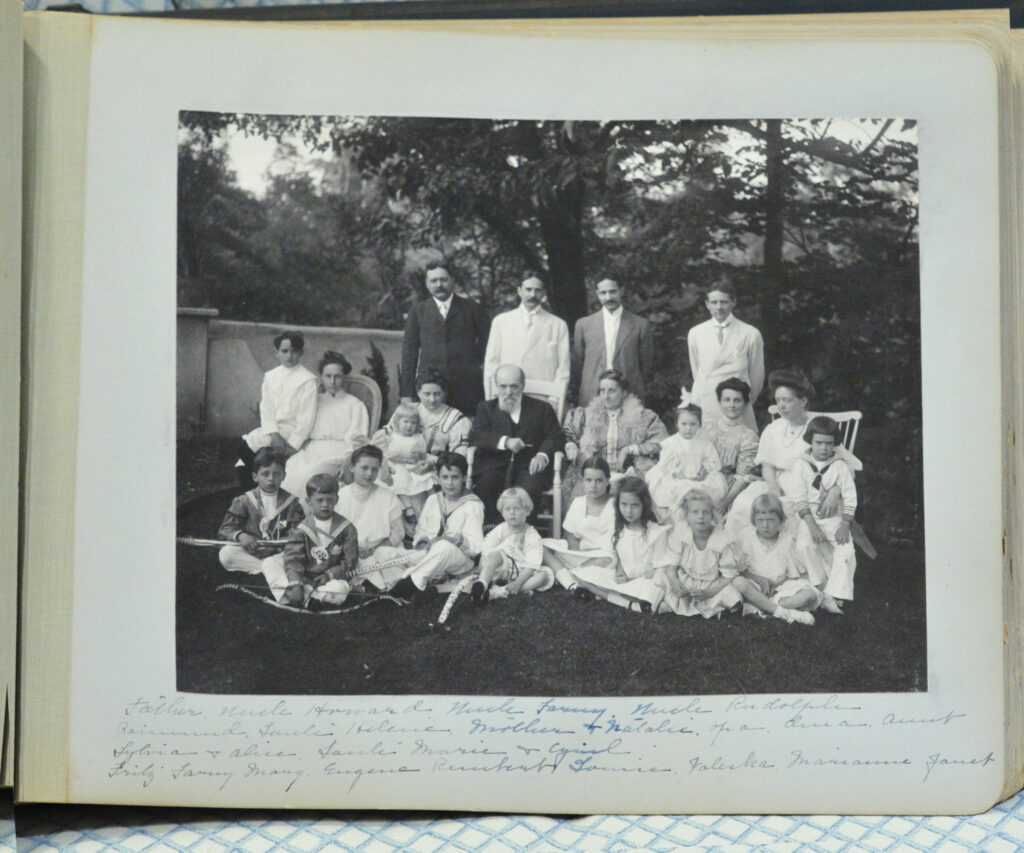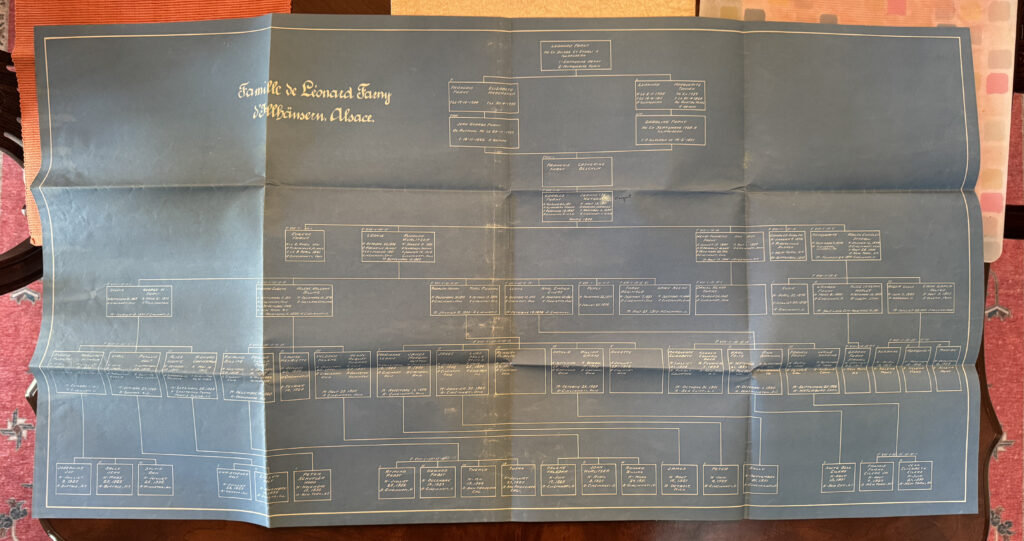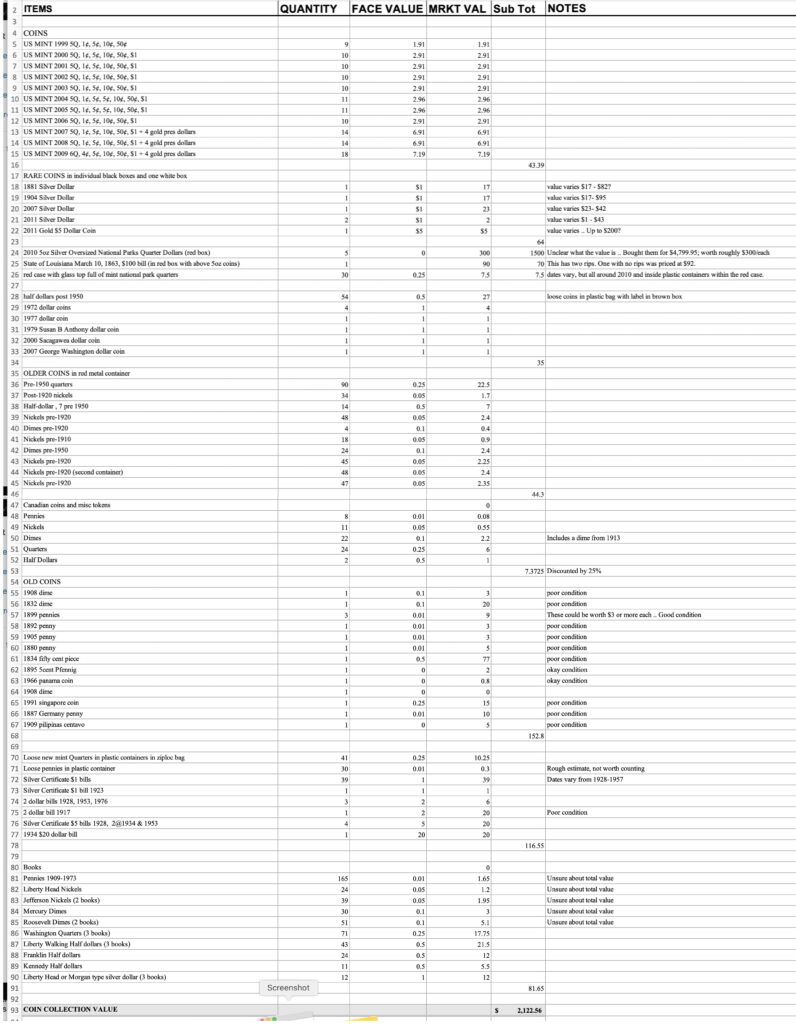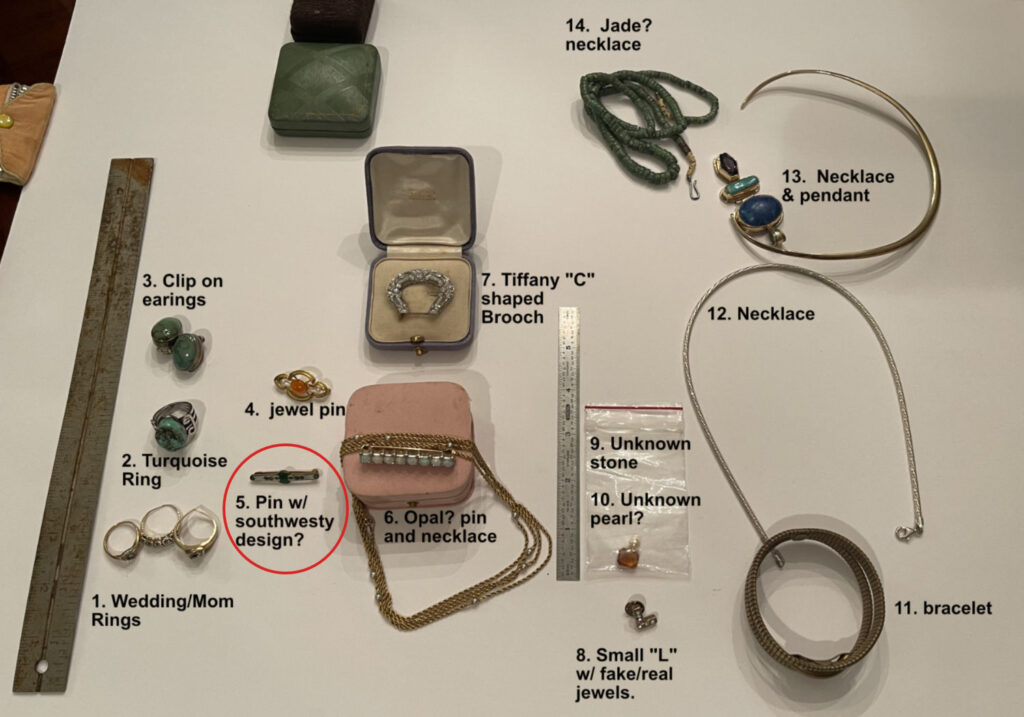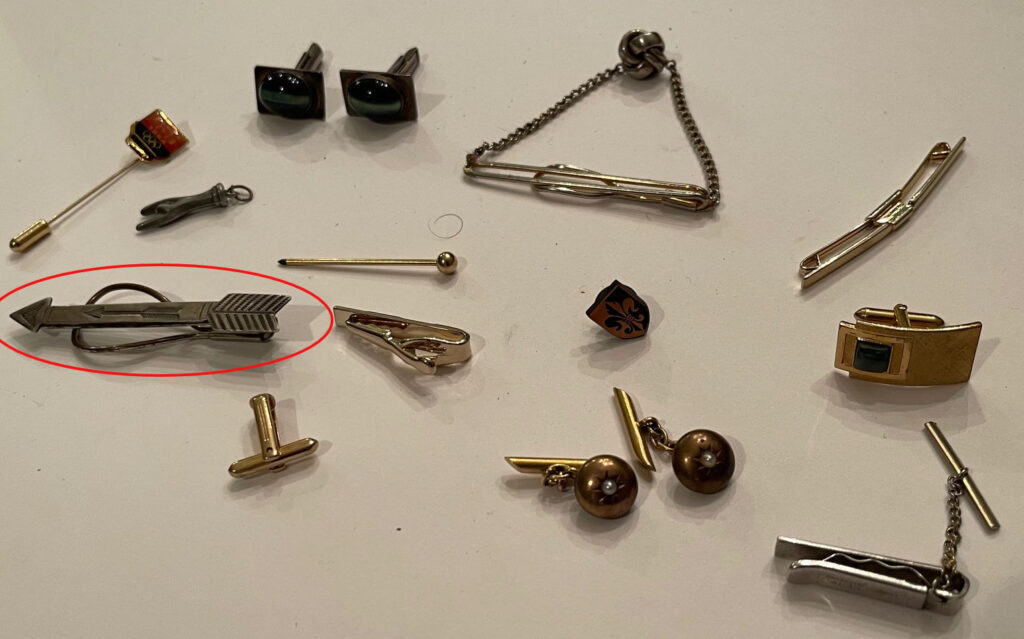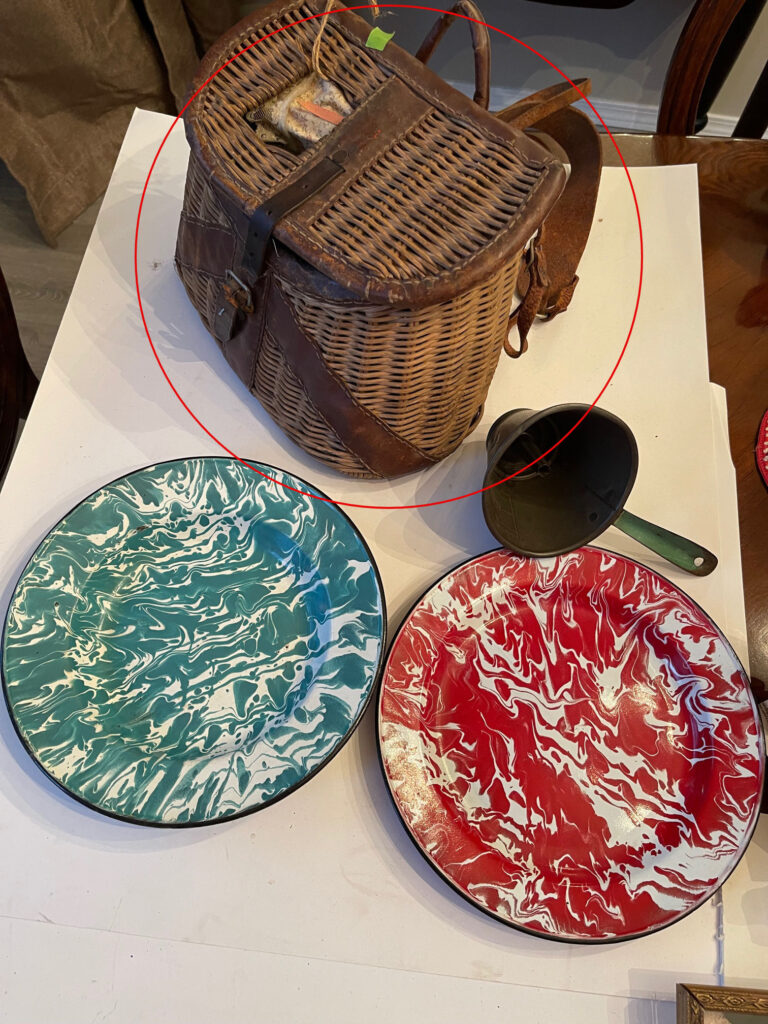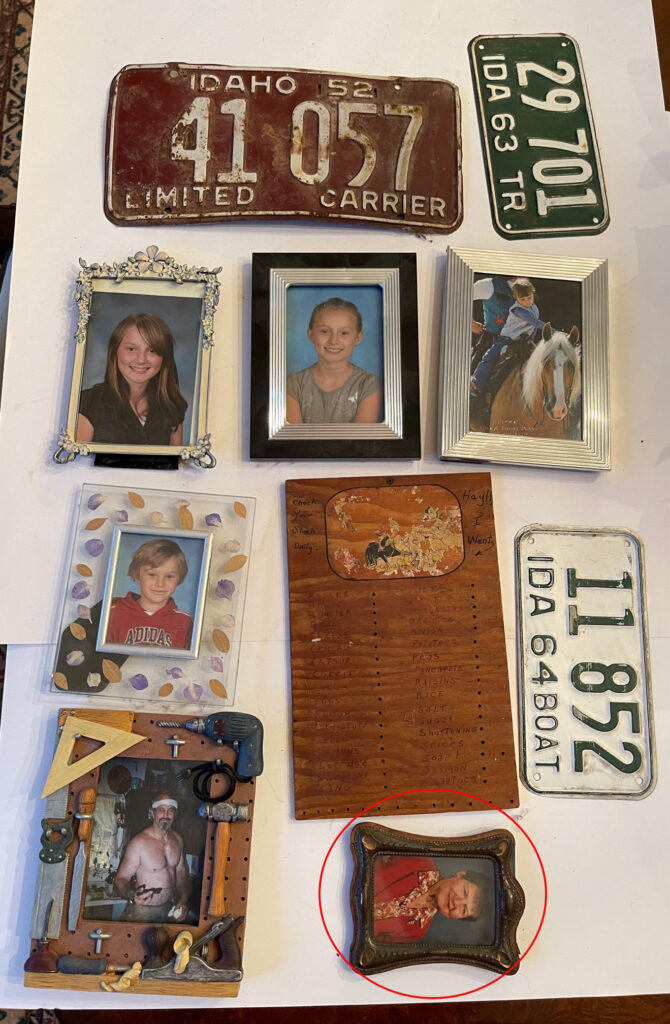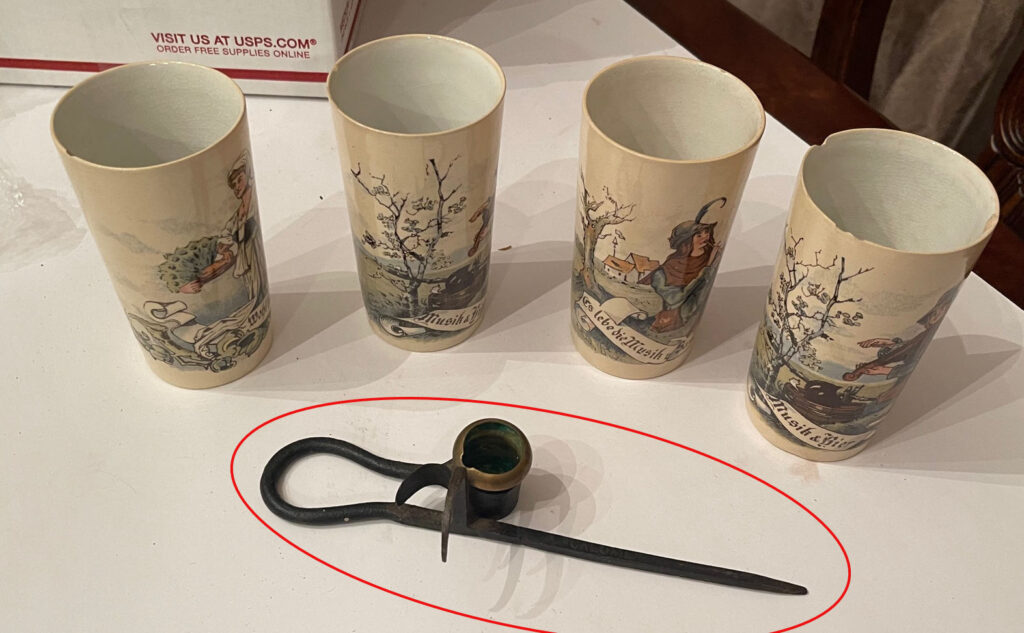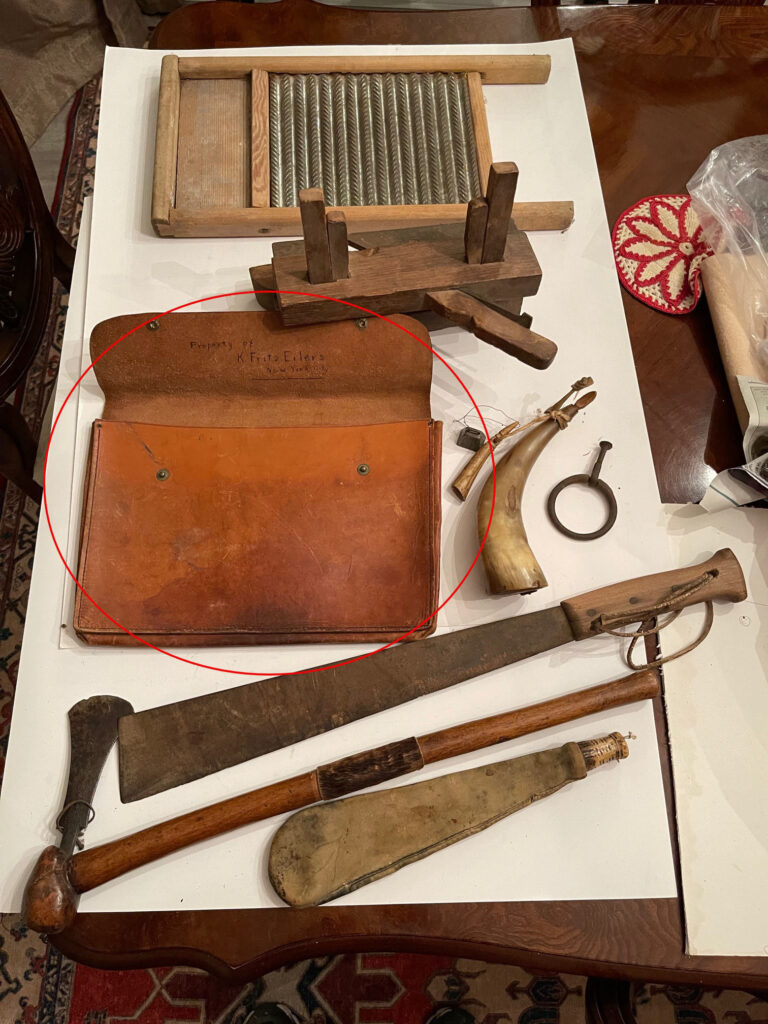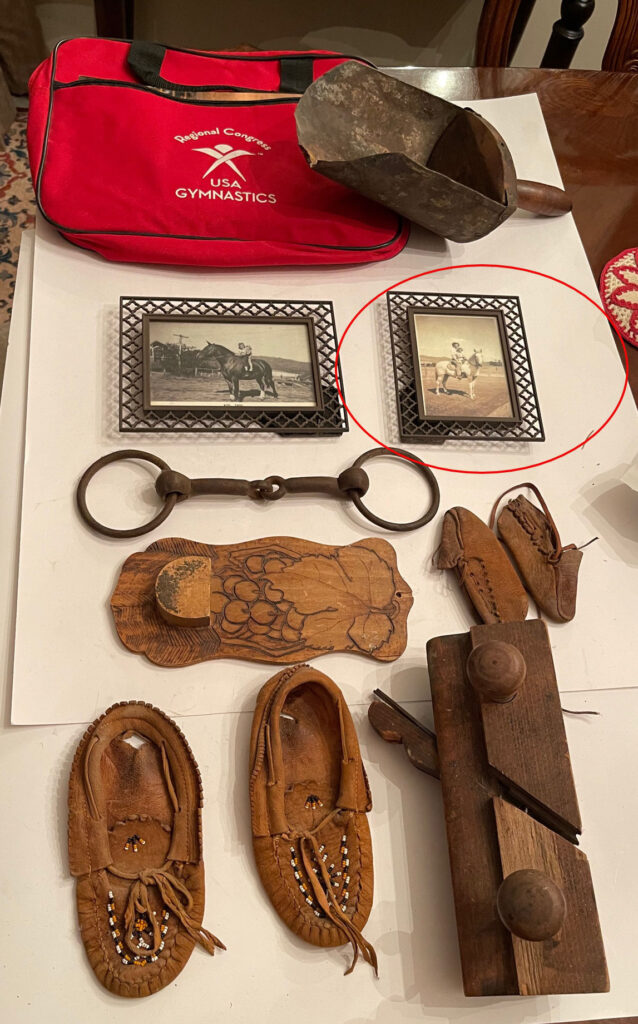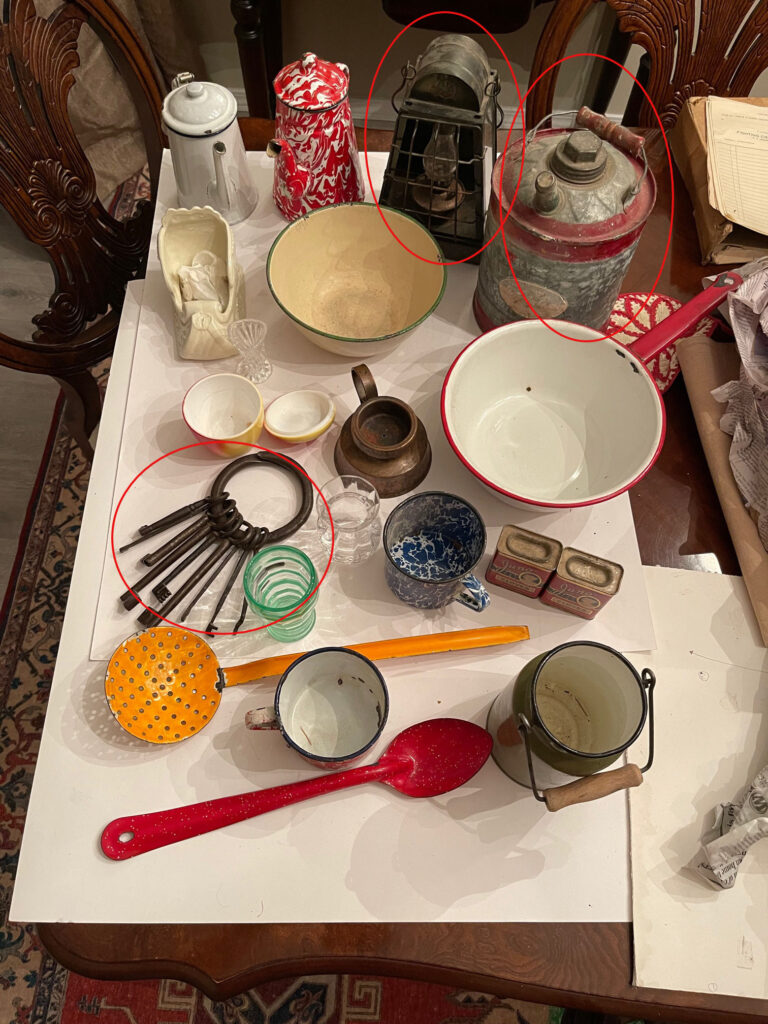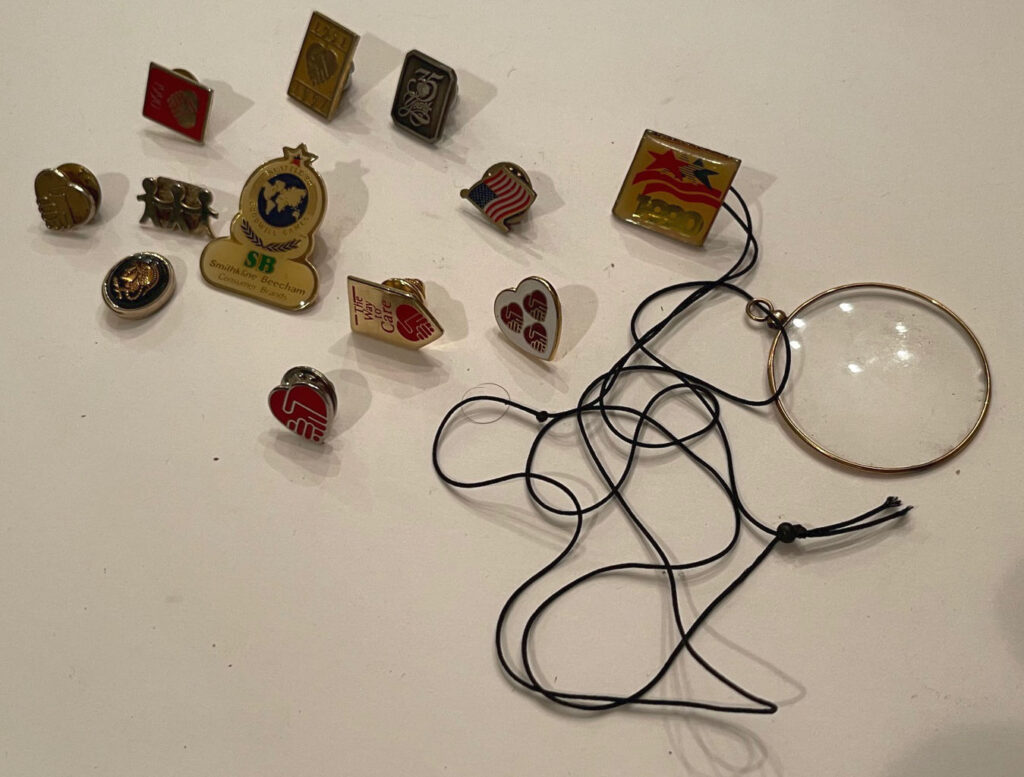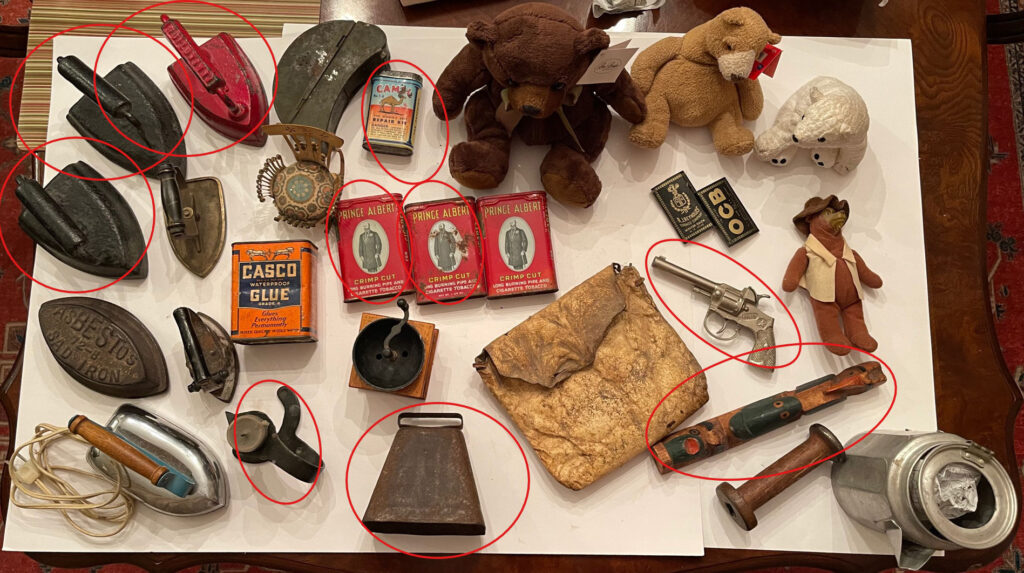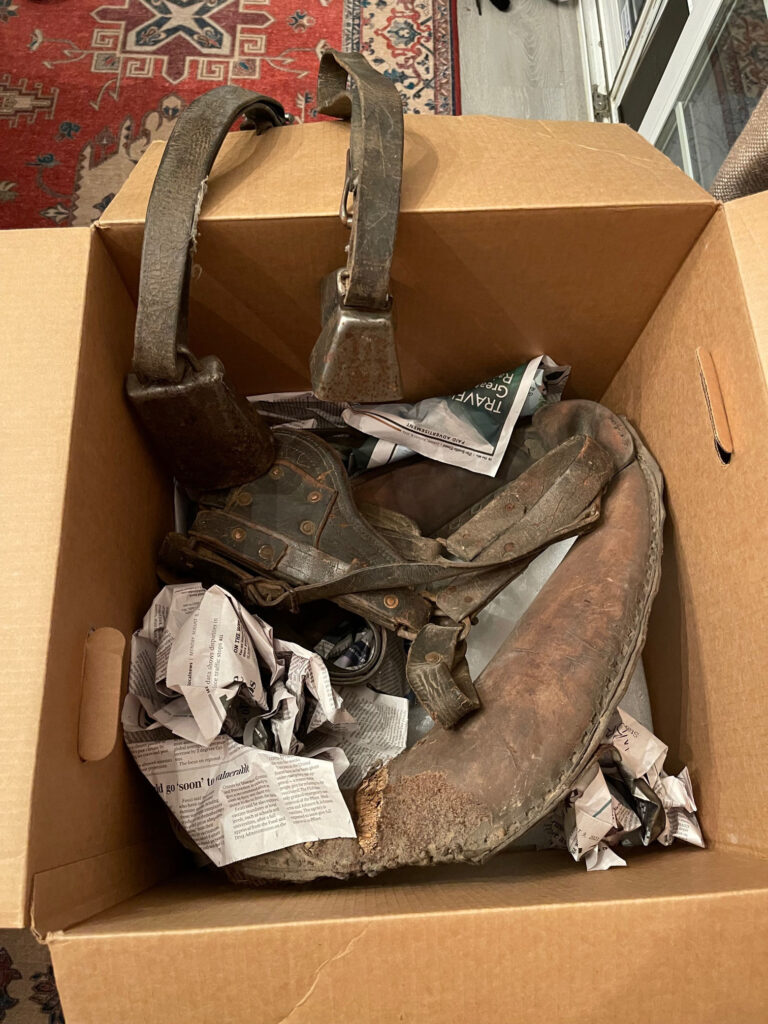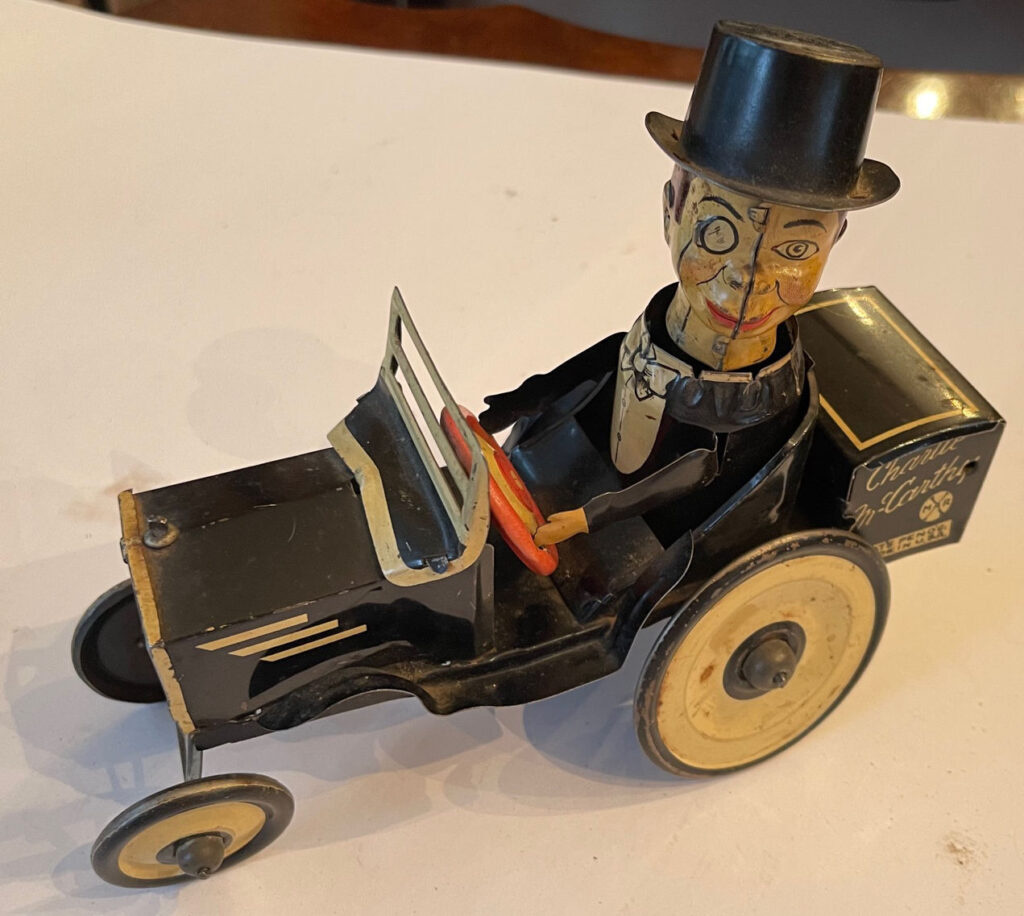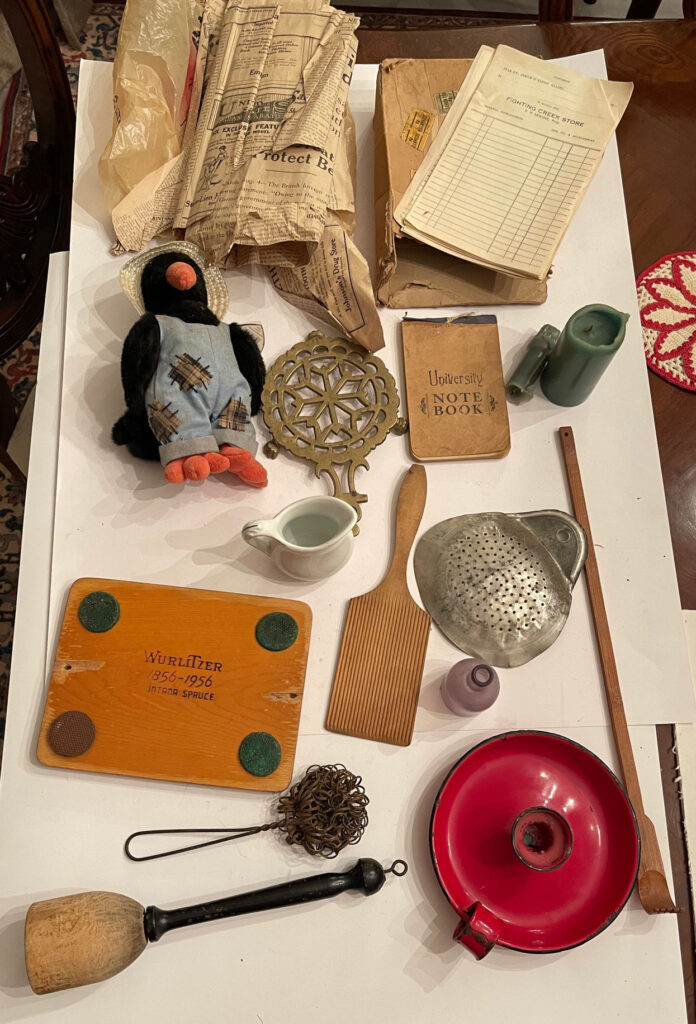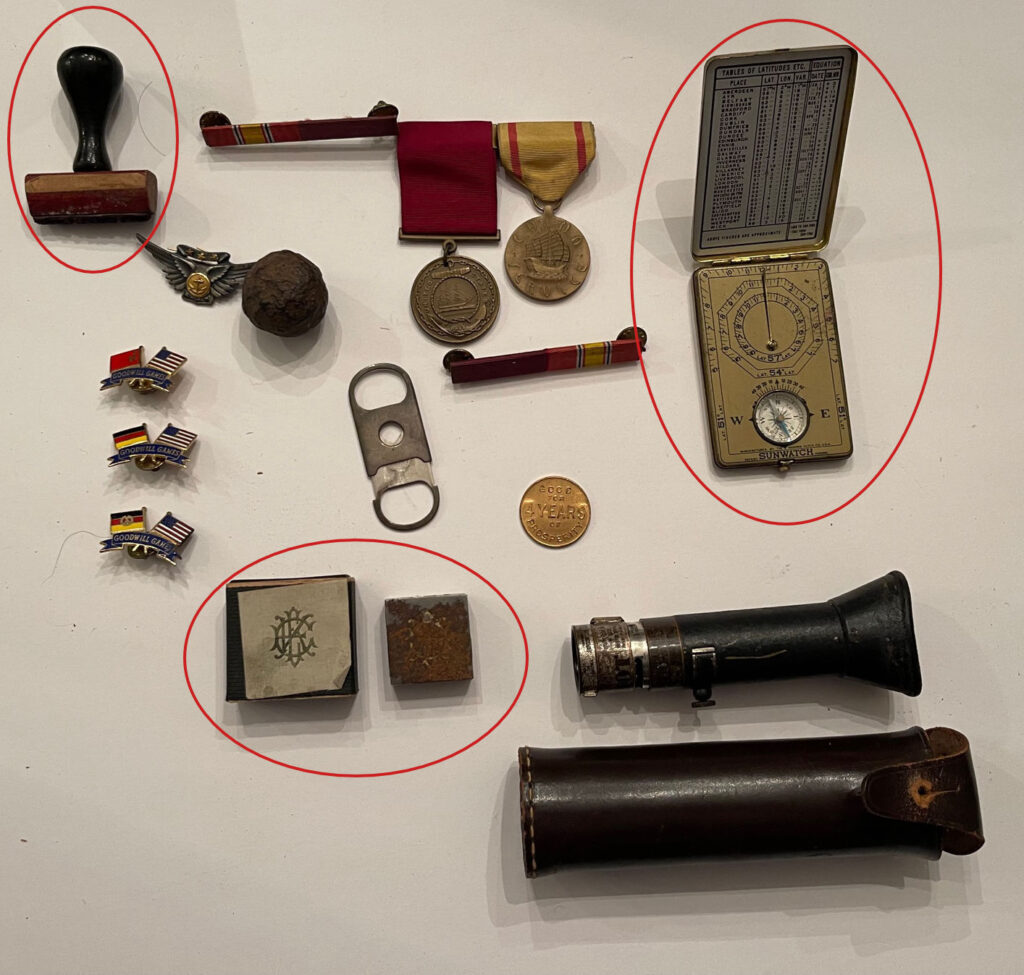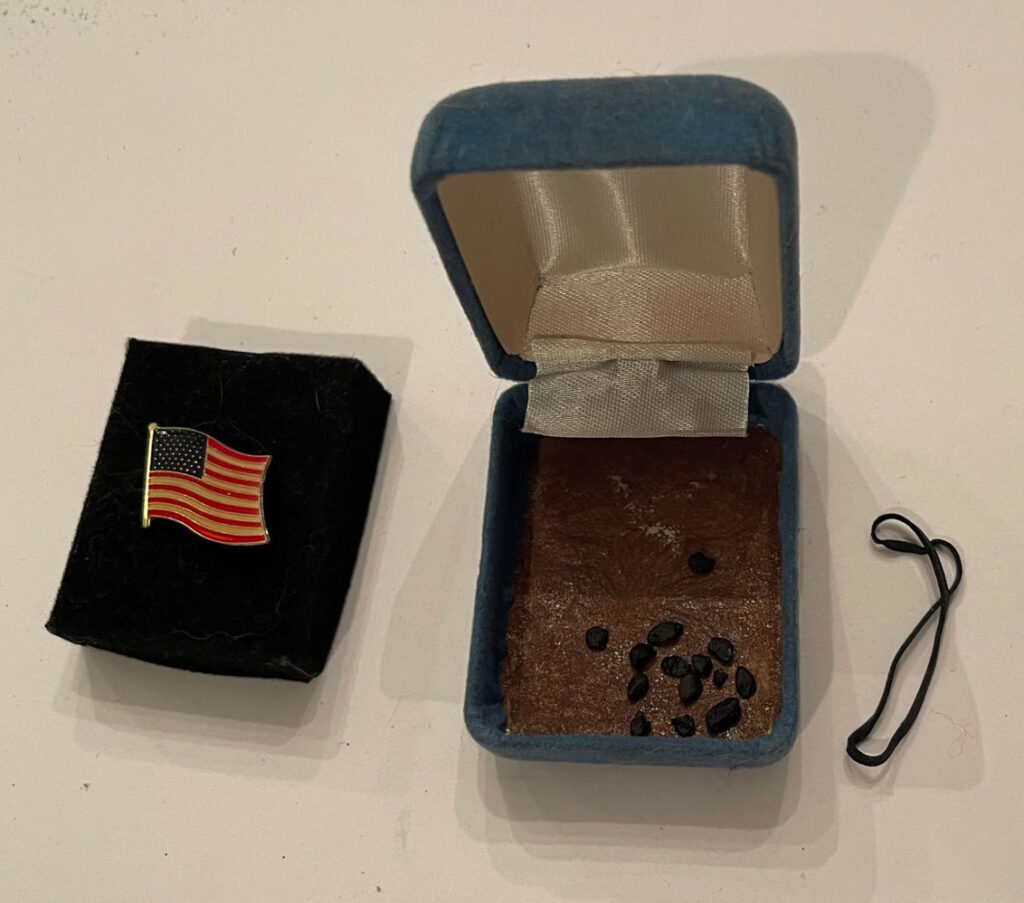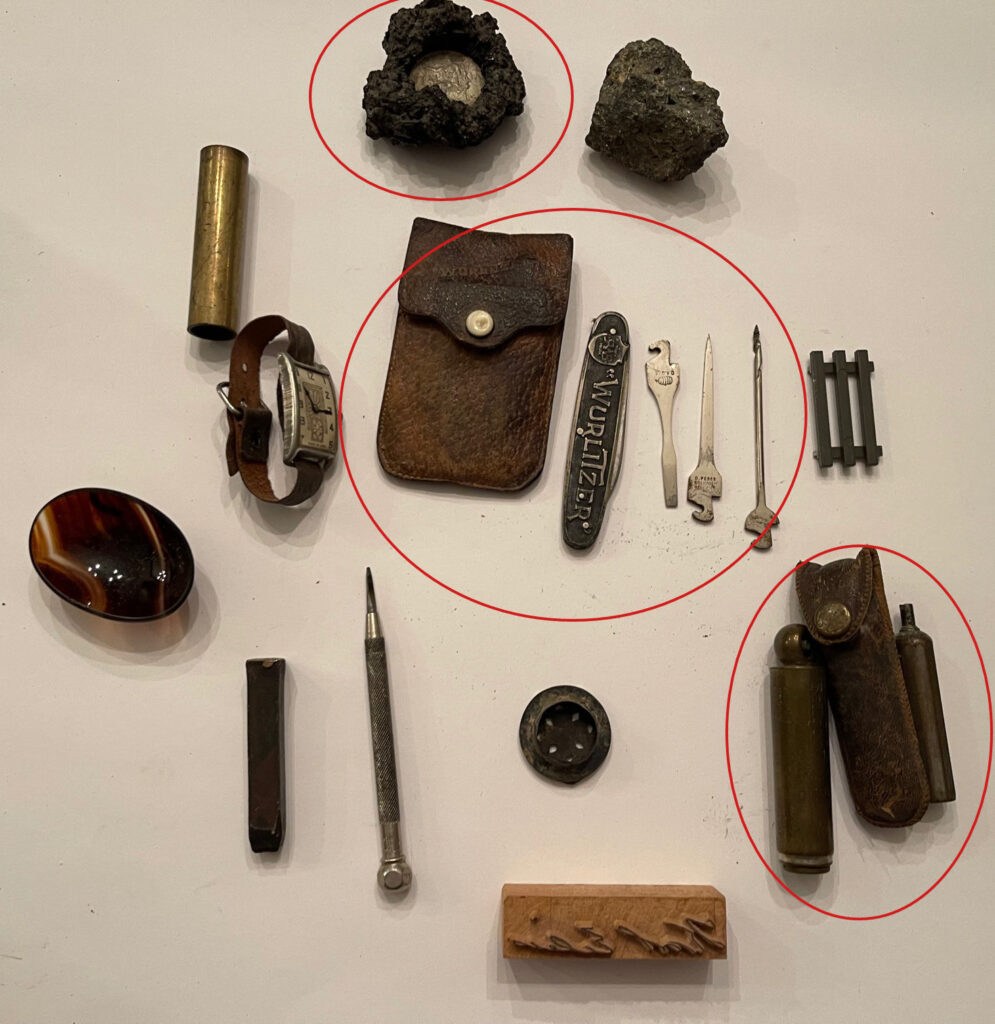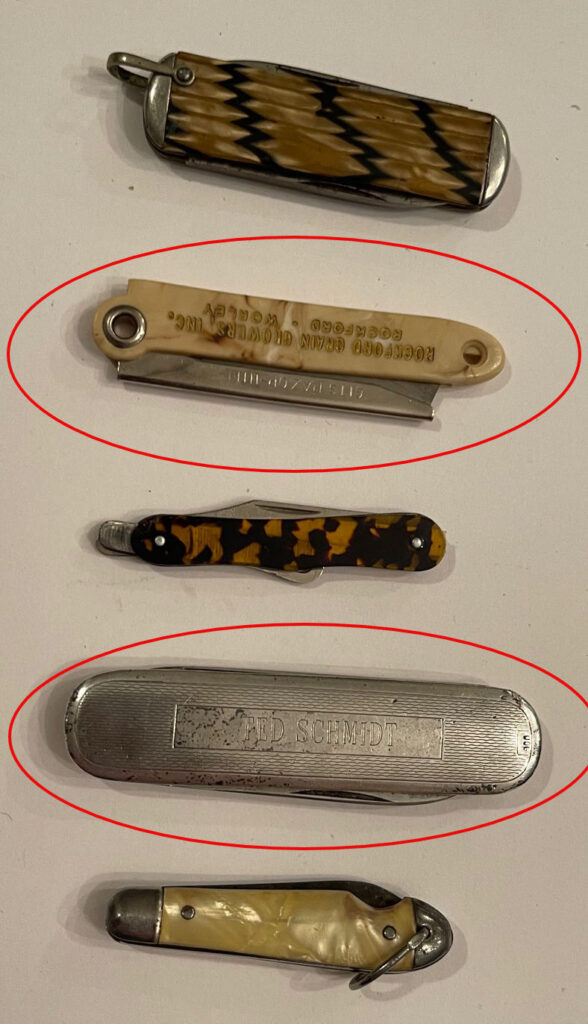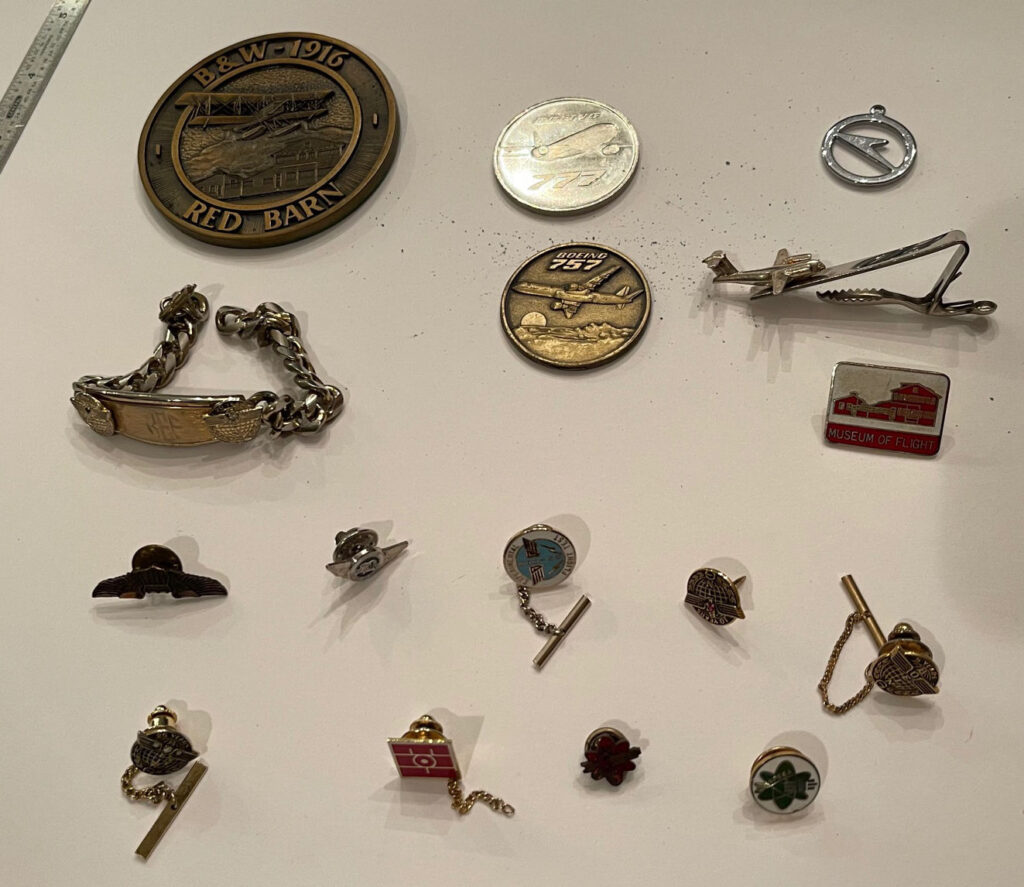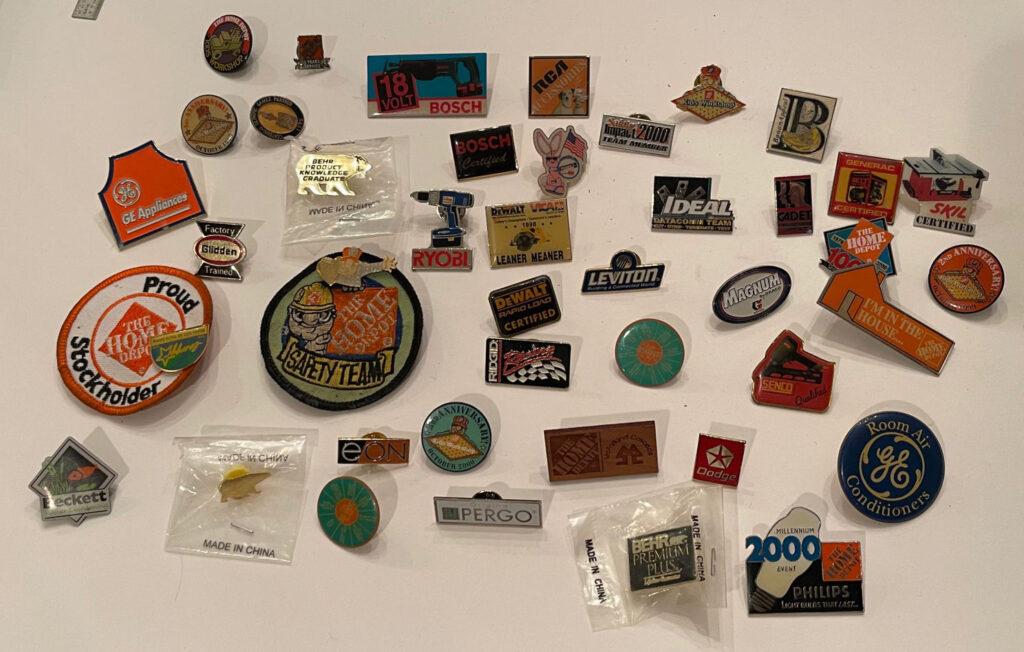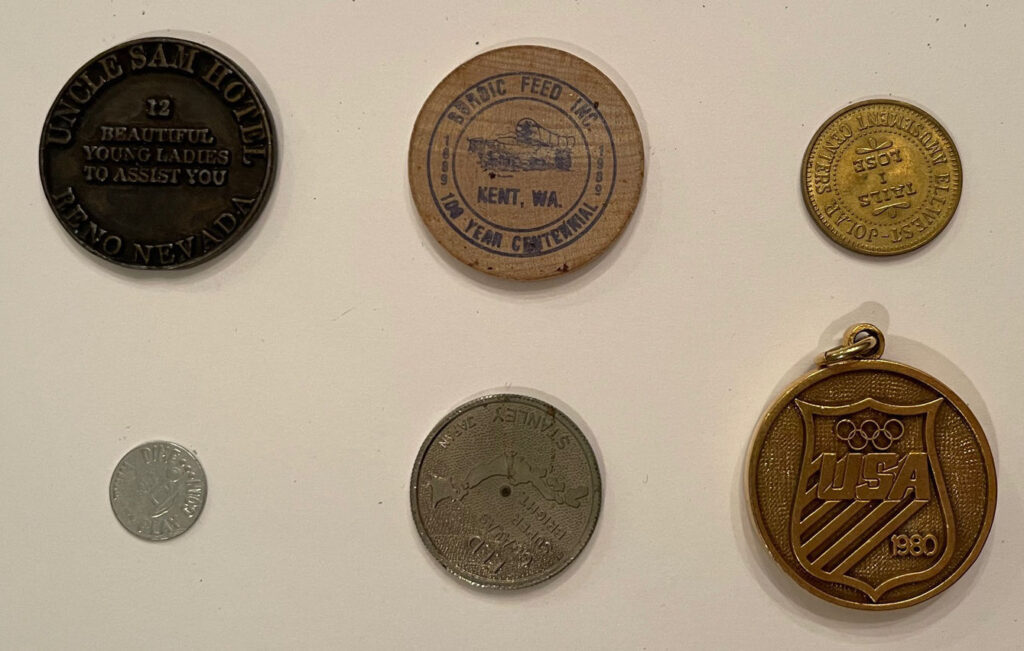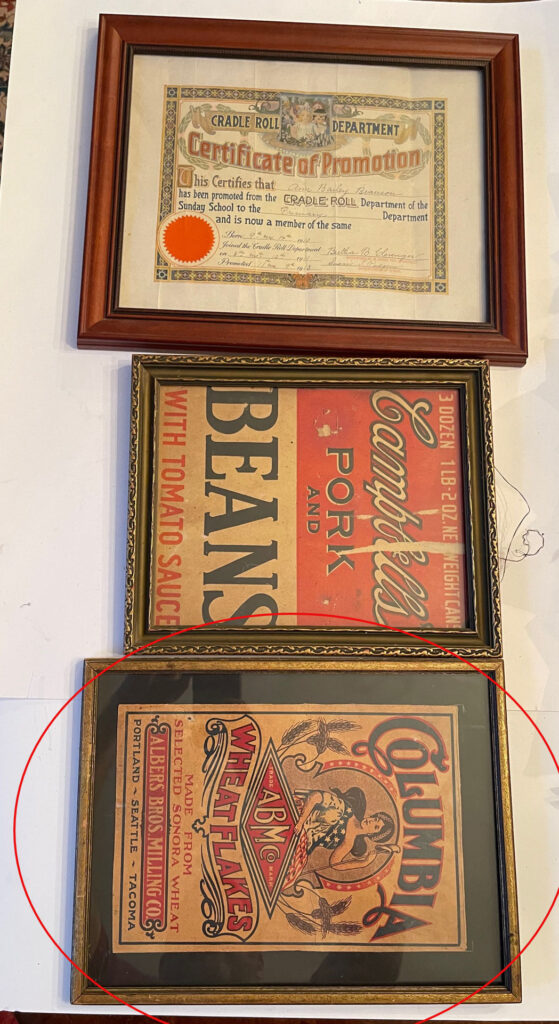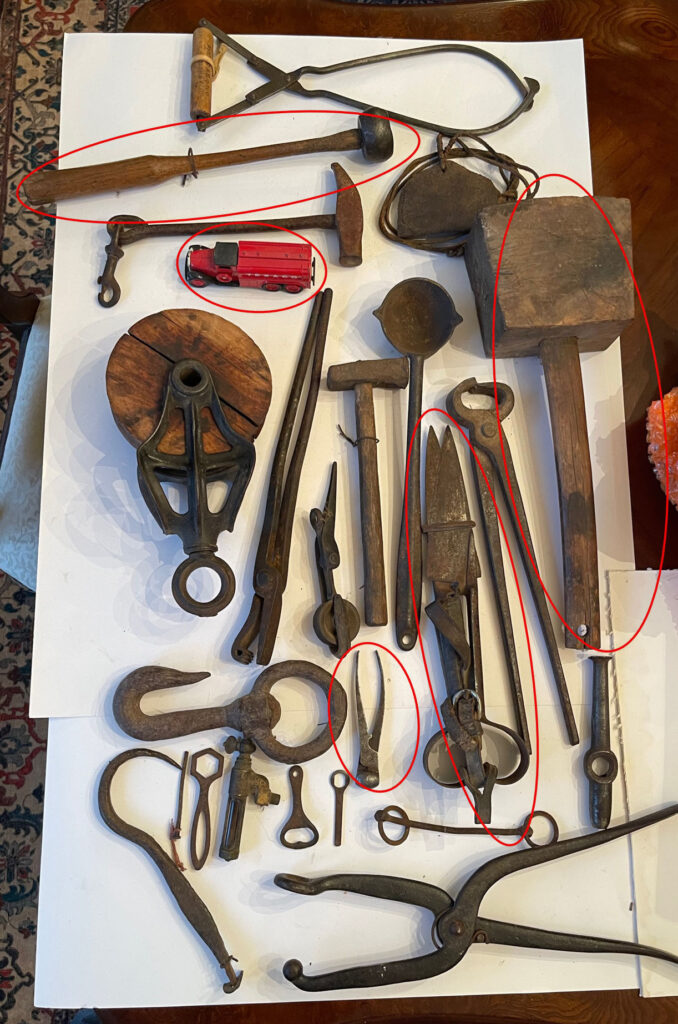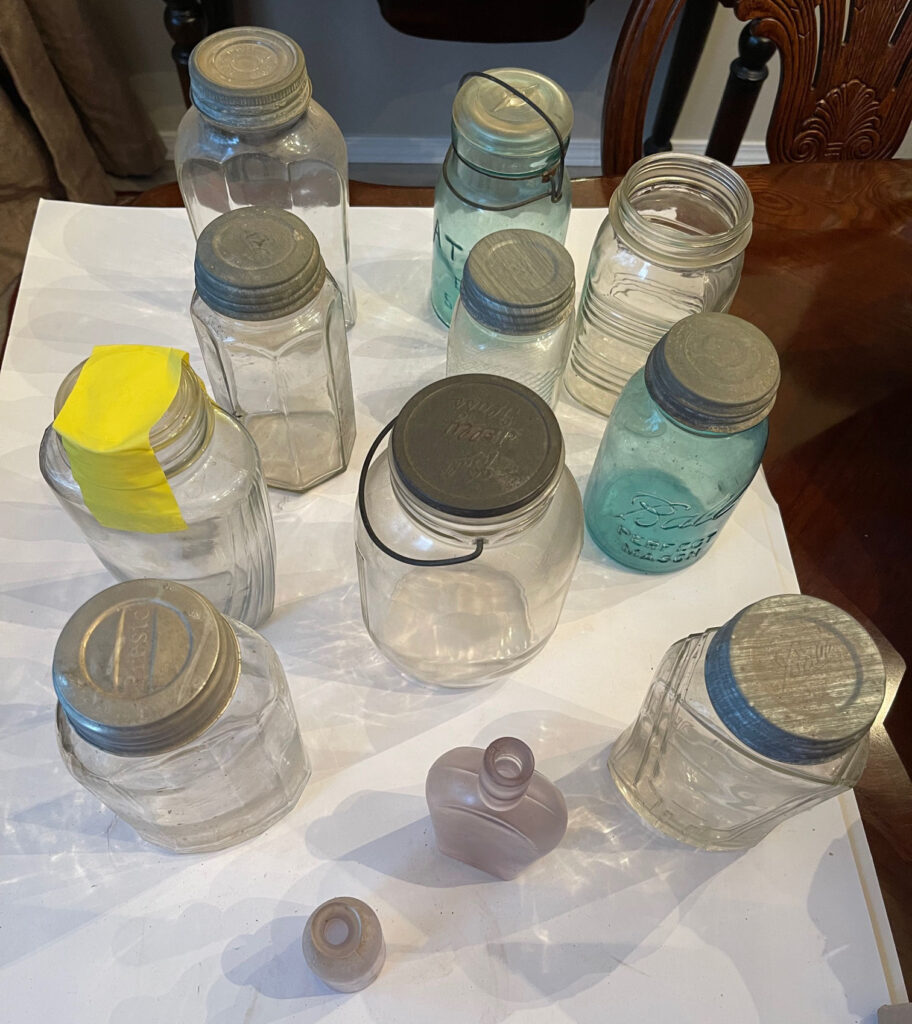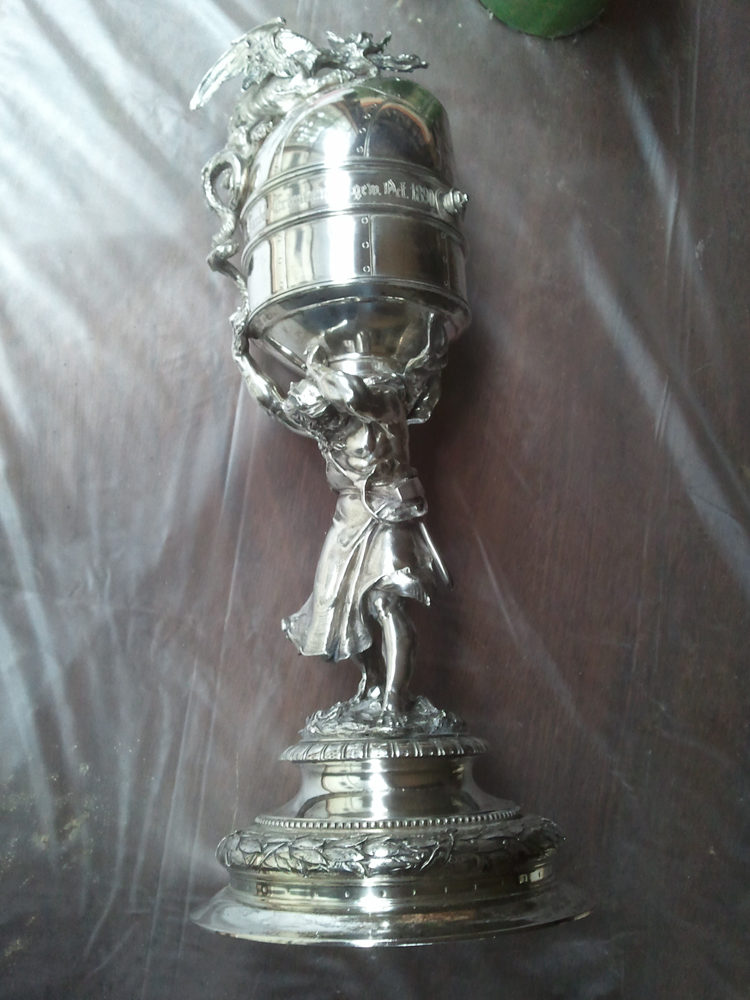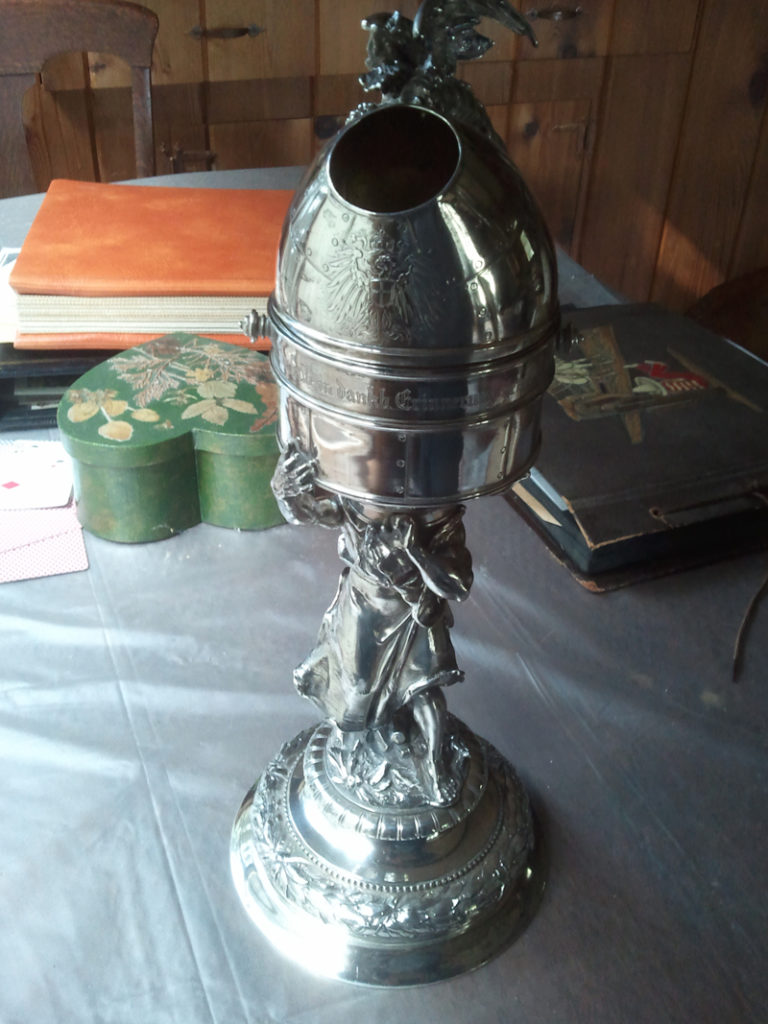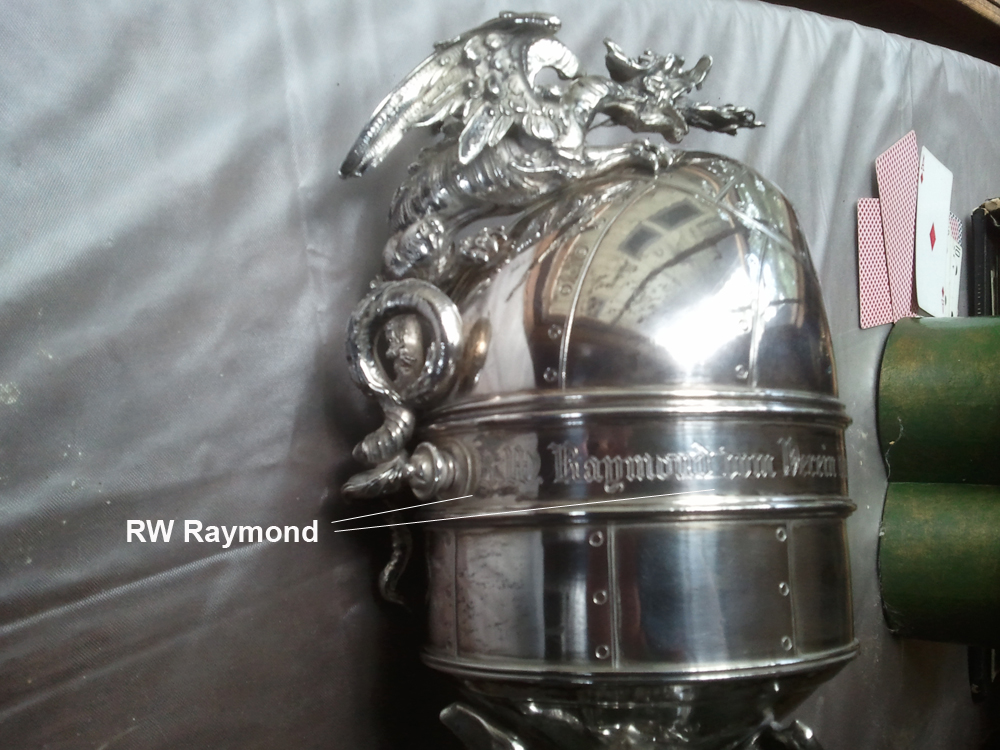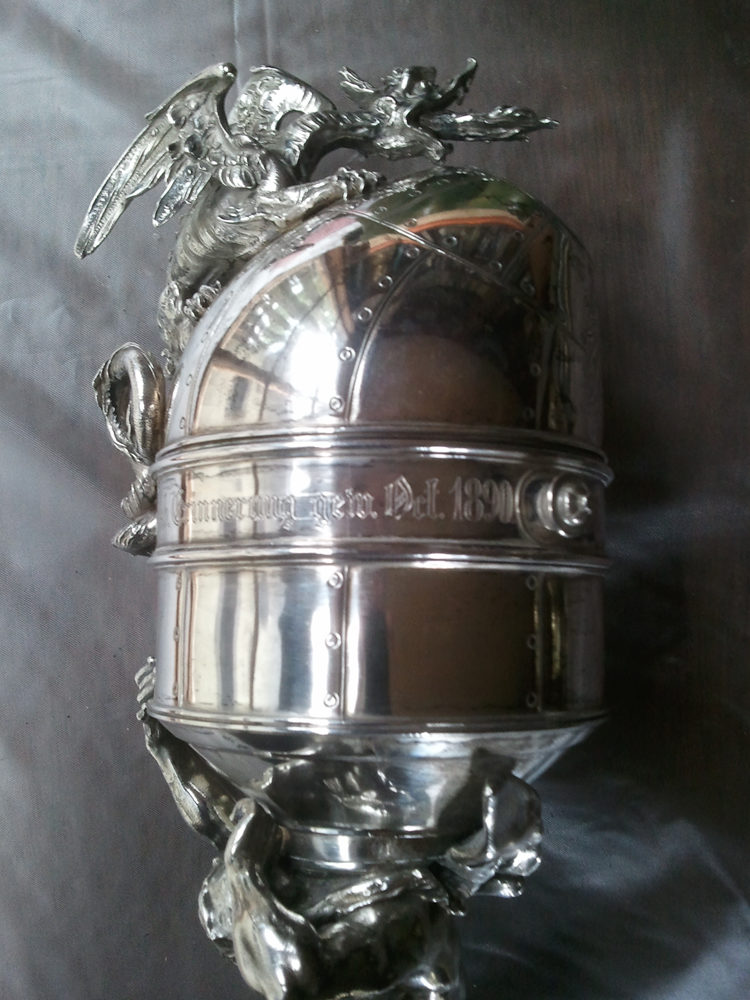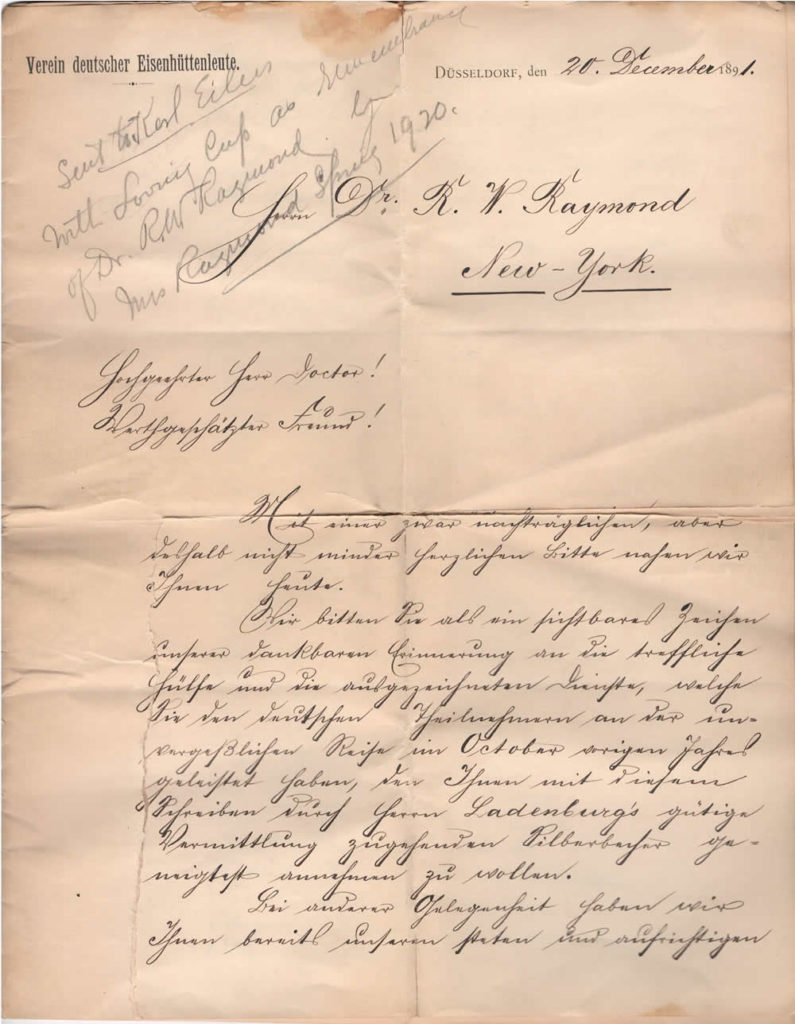Photos of Jeanette Farny
Here are some photos of Jeanette Farny. This first one is from about 1881 according to the back. We photographed this in 2013 at George Ratcliffe’s place in CT (he married Jean Eilers). He has since passed and the image has been passed down to someone.
This 1893 pic was very faded. It’s a rare photo showing the Strobels, Wurlitzer’s and Farnys. We photographed this in 2013 at George Ratcliffe’s place in CT.
Here is Jeanette and Josephine, date unknown. It was owned by Francis Farny Eilers, jr. He has since passed and I believe his son David Eilers owns it. I have a recording of our time together as well. He was a kind man.
This photo was taken in 1880. It was also owned by Francis Farny Eilers, jr.
1924 Europe Trip Photos
Here are some photos that include Landon Strobel from the 1924 Eilers family trip to Europe. Brothers Fritz and Farny Eilers traveled around Europe and North Africa by car.
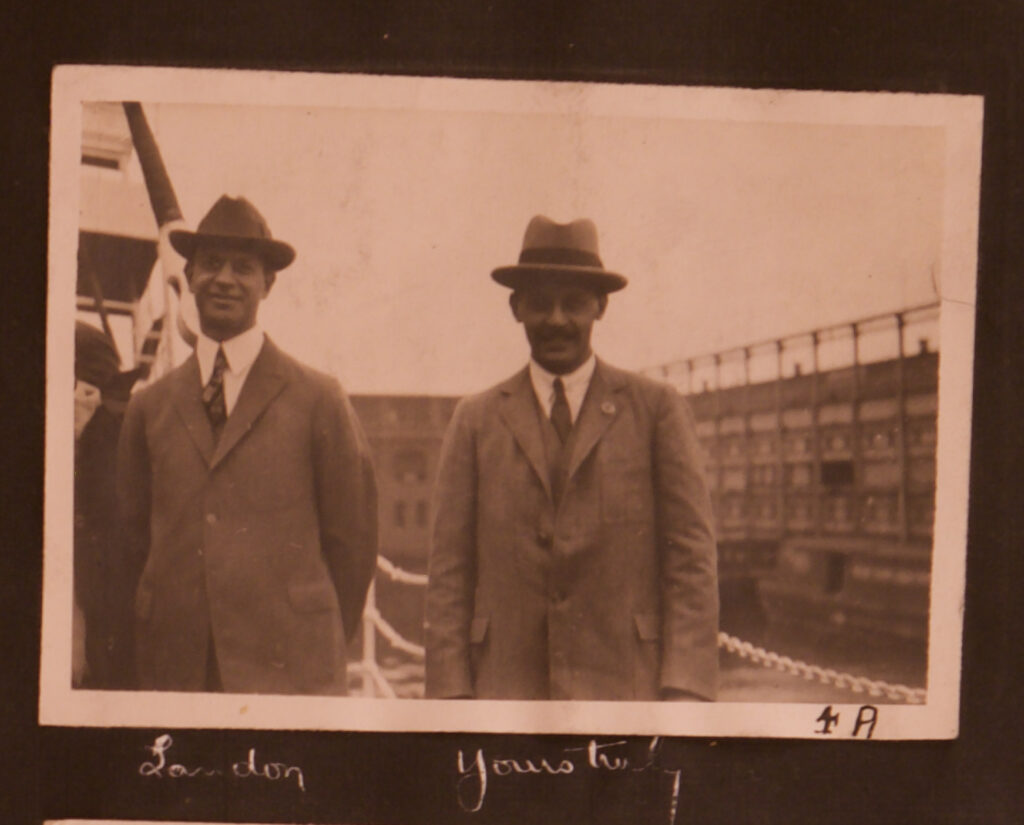
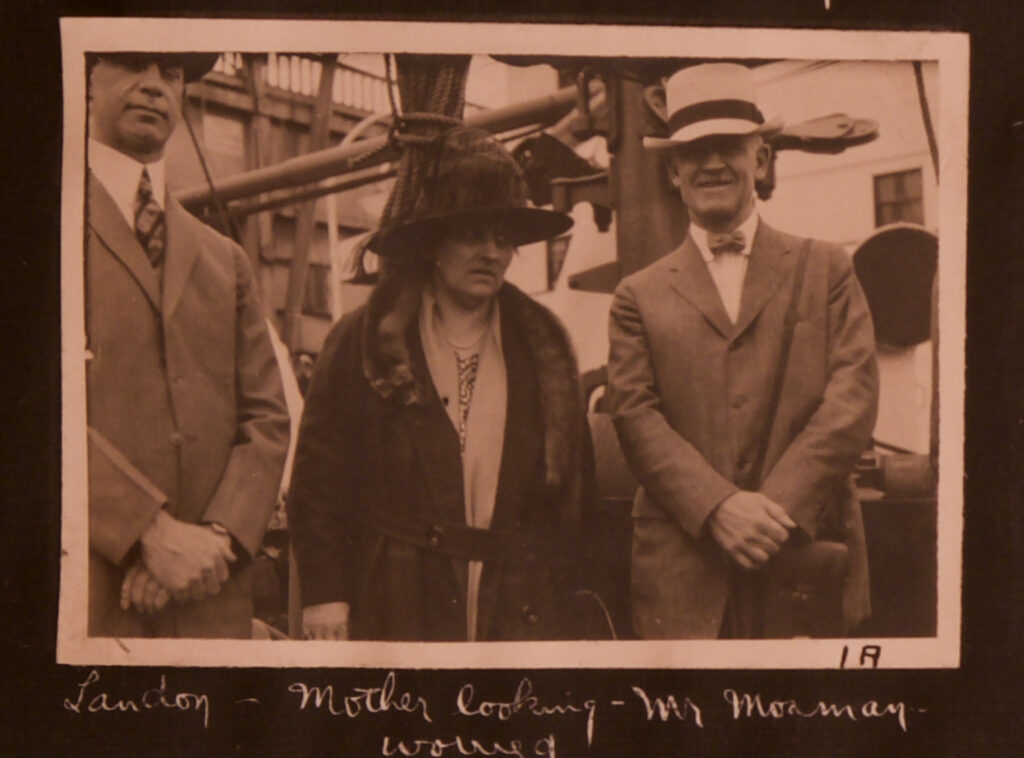
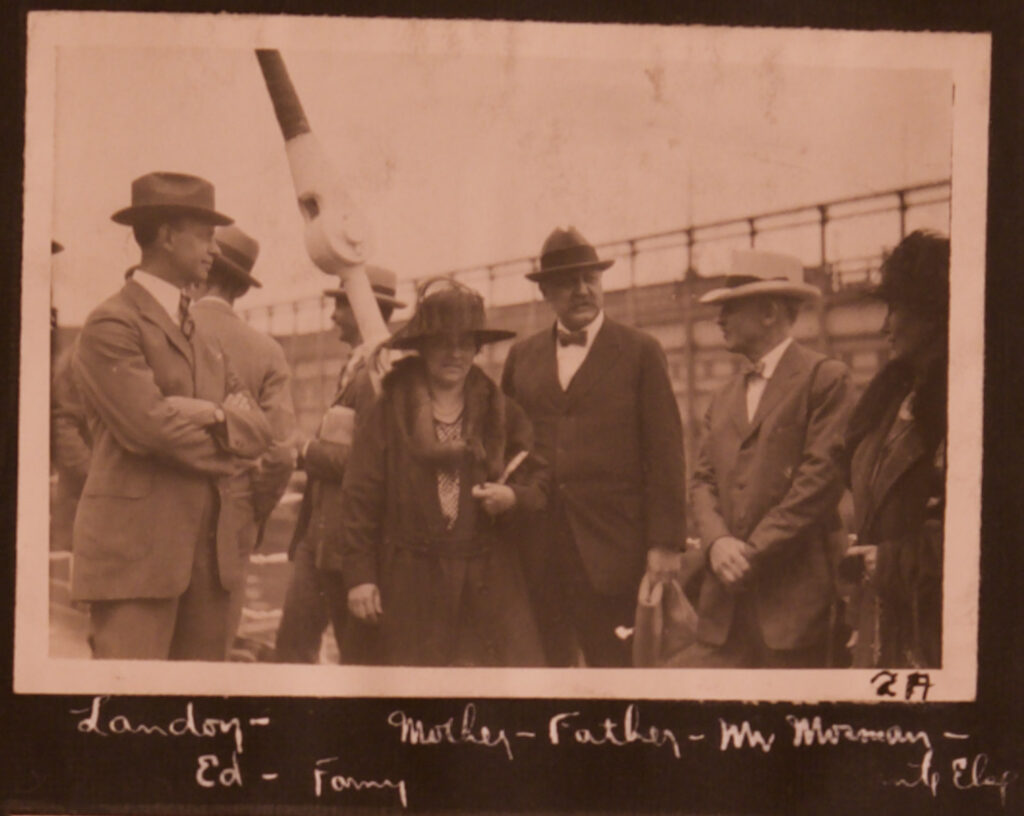
Henry Farny – Lillian Bain Marriage/Mystery
Here is info related to the Henry Farny — Lillian (Lilly) Bain marriage. First of all, do you have a copy of the Wurlitzer/Farny history by Lloyd Graham? If not, here is a PDF: http://www.deilers.com/wurlitzer-and-farny-family-history-by-graham.pdf
Let’s start here, the census from 1880 showing Lillian Bain and her family- see top lines and bottom lines:
I have searched for a wedding certificate and an 1890 census, but had no luck. There are also no newspaper mentions of a Mrs. Henry Farny from between 1887-1905.
1900 census showing Henry Farny, Lilly Farny, and adopted son Ray Thomas (I keep transposing his names):
The final time Lilly shows up is when she passes away.
1906 death certificate for Lillian (Lilly) Farny:
1906-03-19 Cincinnati Enquirer, pg7, col7, Obituary notice published by Lillian’s sister Elizabeth (Bain) Fitzgerald:
1906-03-21 Cincinnati Enquirer, pg7, col7, obituary for Lillian Farny,
1906-03-26 Kentucky Post, pg2, col3, noting that Lillian died of a Cerebral Menengitis,
Was it a charity marriage? An unhappy marriage? No friends of Farny ever mention her. She is also not mentioned in the Graham history of the Wurlitzer/Farny clan, though other love interests of Henry are mentioned.
Finally, there is the note at the very bottom of this page: https://www.norwoodohiohistoricalsociety.org/Farny_HF.html
Just so strange!
Strobel-related Photos
Suzanne, it turns out I didn’t mark many photos with the Strobel name, so it will take me time to assemble some Strobel related photos. Here are a few that might interest you:
This 1893 photo was from George Ratcliff, who has since passed. It is really faded:
This 1903 photo shows the Strobel family in Salt Lake. It was in an Eilers family album. Another not so great photo, but I do have other photos of Eilers/Strobels in the Salt Lake area, but just have to locate them:
In 1924 the Eilers and a few others, including Landon Strobel, left for Europe. My grandfather, Karl Eilers, and his brother Farny spent time deriving around Europe. I believe Landon accompanied them part of the way? Anyway, Landon is shown, at the very least, in the top photos. My cousin Anita Eilers Graves has this album:
You may have these .. photos at the Wurlitzer property in Cincinnati with names (from the George Ratcliff family) (I have higher resolution of these photos):
Here’s a photo of my copy of the large family tree that was created circa 1932:
Items
Below are items brought over from Mom’s before she passed. Some of the items we packed in boxes and some Marilyn packed in boxes, so some items were a surprise to us.
Firstly, mom and dad collected various cash and cash equivalent coinage. Most of it is not in very good condition, so the actual market value isn’t all that great. The most valuable items are the oversized national park quarters (5 oz silver). They are listed at roughly $300 each on ebay, but their actual value seems less than that.
I say we divide this in half as best we can:
Below is a list of jewelry we have (and a Kodak movie camera at bottom). Two items I’d like are the southwest pin and the Kodak camera (and the light meter, though something is rattling inside, so it is likely broken).
As for the rest, there’s nothing in particular I want, so you are welcome to it. My guess is that there is around $10k of value here.
This bear housed a set of pearl(?) earring and a necklace. I don’t necessarily want it, but what we would like is the set of pearl earrings Mom let Ann wear at our wedding, which you may have? If you’d be willing to trade them for this bear+earings+necklace that would be great.
Below are other items. I have circle the ones I would be interested in retaining. Explanations below:
This pic shows some of Dad’s jewelry. The arrow tie clip interests me.
In the pic below, Grandpa Schmidt’s fishing gear interests me (Ann likes to fish):
In the pic below, only Grandma’s pic interests me. I believe the pic of Dad was taken at your former house, so I thought you’d like to have that (along with your kid pics).
I’d like the miner’s candle holder. I’ll take the German cups, but if you want them more, then take them.
In the pic below, the portfolio case has “Karl Fritz Eilers” inscribed in it. So, I’d be interested in that. I’d like the tomahawk, but only because I’d be interested in seeing if there is any cultural value in it for a museum.
I am sure you are familiar with the two pics below. I’d like the one circled. A museum might be interested in the moccasins, but I haven ‘t check into that.
In the pic below, I’d like to keep the lantern, metal jug, and keys.
The pic below is Dad’s collection of United Way pins. They don’t interest me, but I do know someone who works at United Way who might be interested in them:
In the pic below, I am interested in the three irons (Ann can use them for quilting), two of the Prince Albert cans, the camel can, the candle holder, the cowbell, the toy gun, and the small totem pole.
In the pic below is a harness and two bells on straps:
In the pic below, I’d be interested in the milk jug. I’d take the eggs in the basket, as well, but not a priority for me.
The pic below shows the Charlie Mccarthy toy. I will keep it unless you want it.
The pic below includes a Wurlitzer Centennial hot pad (?) cork on the down side and an inscription on the back that marks it as a centennial piece. I wouldn’t mind having the Wurlitzer piece, but not a priority.
In the pic below is a very tiny cap(?) gun with charges contained in the two pill-like containers. I’d like to keep this.
In the pic below is more of Dad’s stuff, including what I think are some of his ribbons. I’d be interested in the rubber stamp (great grandfather Karl Emrich Eilers), the WWII compass, the KEE stamp (great grandfather Karl Emrich Eilers, though it rusted, so it needs to be de-rusted to be any good), and the light meter (un-circled).
These are dad’s patches from Home Depot. I’ll keep them unless you really want them.
The pic below shows two of Dad’s belt buckles, his Boeing ID, and his golf score recorder:
This flag pin box contained some small nuggets. It’s unclear to me what they are, but I have no interest in them.
The pic below shows Dad’s pins. Some are related to Boeing. The one that interests me is the texaco pin (prob from Myrl’s estate?).
The pic below shows more dad’s stuff. I’d be interested in the 1922 Italian coin embedded in slag (I believe this was a piece of memorabilia from Grandpa Eilers 1924 trip around Europe), the Wurlitzer knife (it is missing some parts .. unsure how the loose items attached to the knife), and the vintage air pressure gauge (could have been great grandpas, as he had a habit of checking air pressure and recording those numbers).
In the pic below are Dad’s knives. I’d be interested in the one from “Rockford”, which is actually a box cutter, and the Ted Schmidt inscribed knife, which is is a standard pocket knife.
These show some Boeing specific memorabilia:
This pic shows Dad’s collection of Home Depot pins:
These are random tokens Dad collected.
In the below pic, I’m most interested in the book ends and the statuette:
In the pic below, I’m most interested in the Columbia Ad, since we are near the Columbia River. The top frame pic is Grandma Eilers promotion from the cradle roll to Sunday school.
There are five items below that most interest me:
Of this glassware, nothing really interests me:
1891 Loving Cup Gift To Rossiter Raymond
This Loving Cup was given by a German contingent to Rossiter Raymond in December of 1891, accompanied by the following letter in German. The cup itself is dated October 1890. In 1920 it was given to Karl Eilers as a remembrance of Rossiter. The Eilers and Raymonds were longtime friends.
(In German) —
Dieser Liebend Cup wurde von einem deutschen Kontingent an Rossiter Raymond im Dezember 1891 gegeben , durch den folgenden Brief in deutscher Sprache begleitet . Der Becher selbst ist vom Oktober 1890. Im Jahre 1920 an Karl Eilers als eine Erinnerung an Rossiter gegeben wurde. Die Eilers und Raymonds waren langjährige Freunde .
Note About Anton Eilers Birth
This note was dated November 28, 1929, and discussed Anton’s birth.
November 28, 1929
Else F Eilers And K. Eilers
Ueber Friedrich Anton Eilers
Friederich Anton Eilers geboren zu Laufenselden, Nassau, am 14 Januar, 1839, waehrend einer reise der mutter von Mensfelden nach Hof Roedel, dem Besitz seines Vaters.
Er besuchte die gymnasien zu weilburg und wiesbaden in Nassau. Studierte in Goettingen und clausthal; kam in Mai, 1859, nach Amerika. Vermaehlte sich am 3ten Mai, 1863, mit Elizabeth Emrich; geboren in der stadt New york den 10ten Februar 1844 (Ihre Eltern Jacob Emrich aus Bingen a/Rhein und Henreitte Mauer aus Freimersheim, Baiern).
(switches to English)
Luise H. Eilers was born at the Hale Copper Mine near Hillsville, Virginia.
Karl born a the Schramm Farm near Marietta, Ohio, where Friederich Anton Eilers was boring for oil
Rough Translation:
Anton born to Laufenselden, Nassau, on January 14, 1839, during a trip to the mother of Mensfelden to Hof Roedel, the possession of his father.
He attended high schools In Wiesbaden and Weilburg in Nassau. Studied in Goettingen and Clausthal; came in May 1859, to America. Married on the 3rd May, 1863, to Elizabeth Emrich, who was born in the city of New York, February 10th, 1844 (Her parents Jacob Emrich of Bingen a / Rhein and Henreitte Mauer of Freimersheim, Bavaria).
Original Letter:
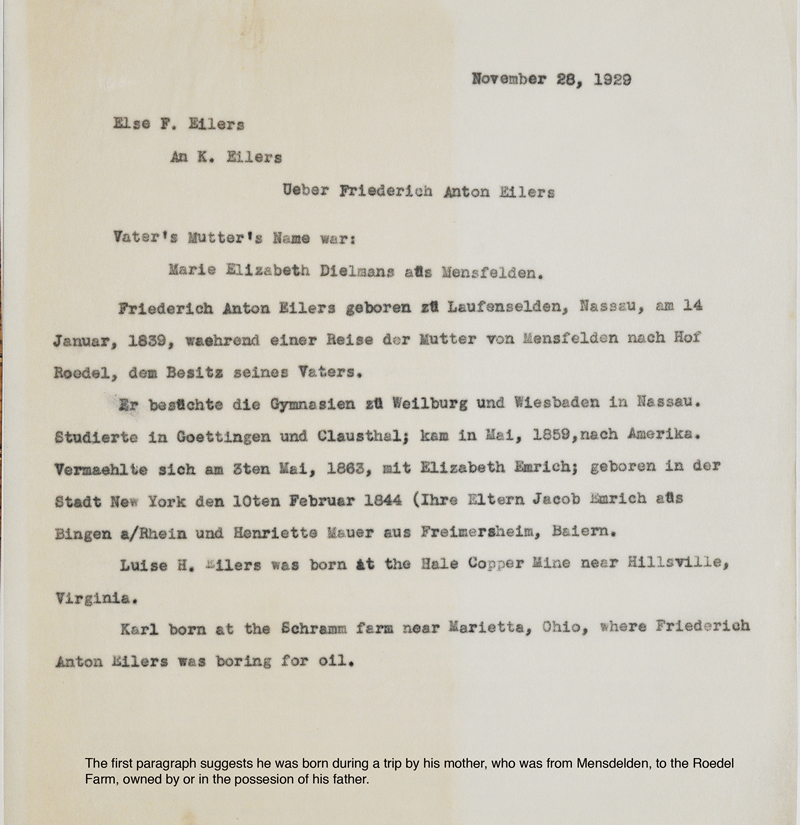
Eilers Family History from Hans Weber
Hans Weber (married to Anna Eilers — brother-in-law to Karl Eilers) sent this written history of the family from notes he had to Karl Eilers in 1927.
Names mentioned: Emma Preu, Emma Karoline Franziska Eilers, Karl Eilers of Ilsenburg, Anna Varges, Anna Tsschnur, Luise Anna Eilers, Friedrich Louis Eilers, Bertha Luders, Friedrich Ernst, Else Fritsch, Karl-Ernst Eilers, Siegfried Eilers, Gunther Eilers, Volkmar Eilers, Rosemarie Eilers, Luise Brandes, Bergrat Brandes (Bergrat Friedrich Brandes).
Regarding Brandes: J. Bergrath ‘Hermann’ Brandes was married to Anton’s half-sister Luise Eilers Brandes. Luise was the youngest of Anton’s four half-siblings. In the biography of Ernst “Fritz” Eilers, author unknown, Brandes was initially referred to as Hermann Brandes, but that was crossed out on the document in favor of J. Friederich Brandes. In Else Eilers’ compilation of history, she called him Bergrath Brandes. Below, Hans Weber called him Bergrat Friedrich Brandes. I have used Hermann herein simply because it is easiest to pronounce.
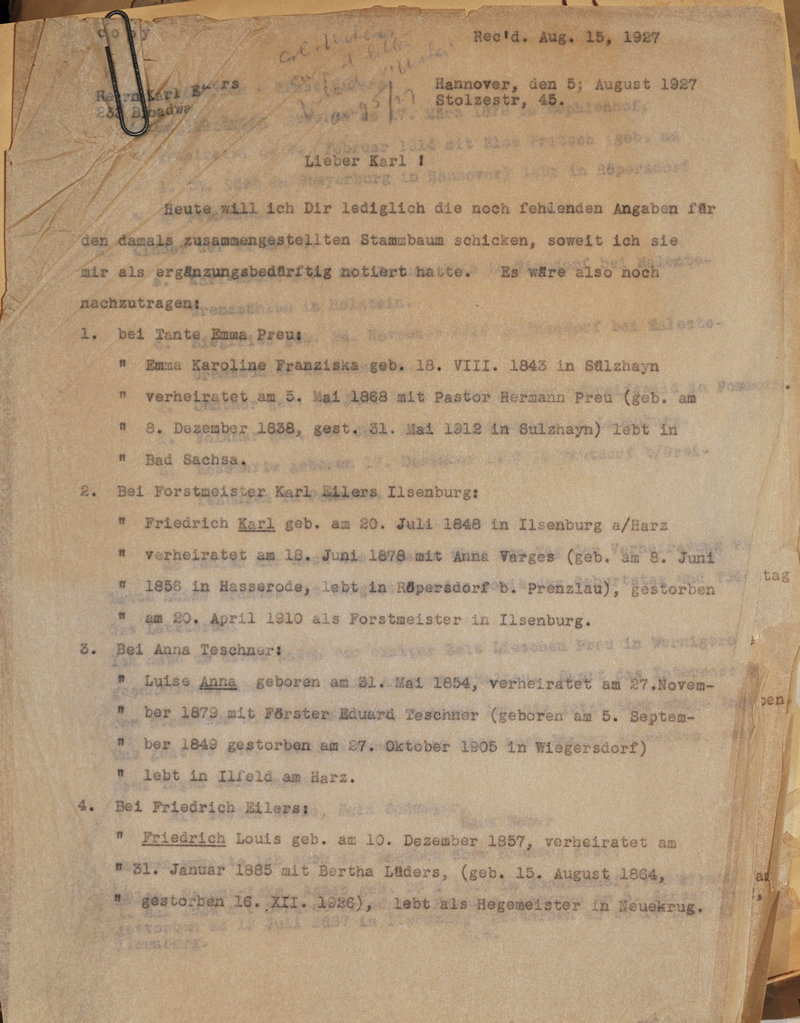
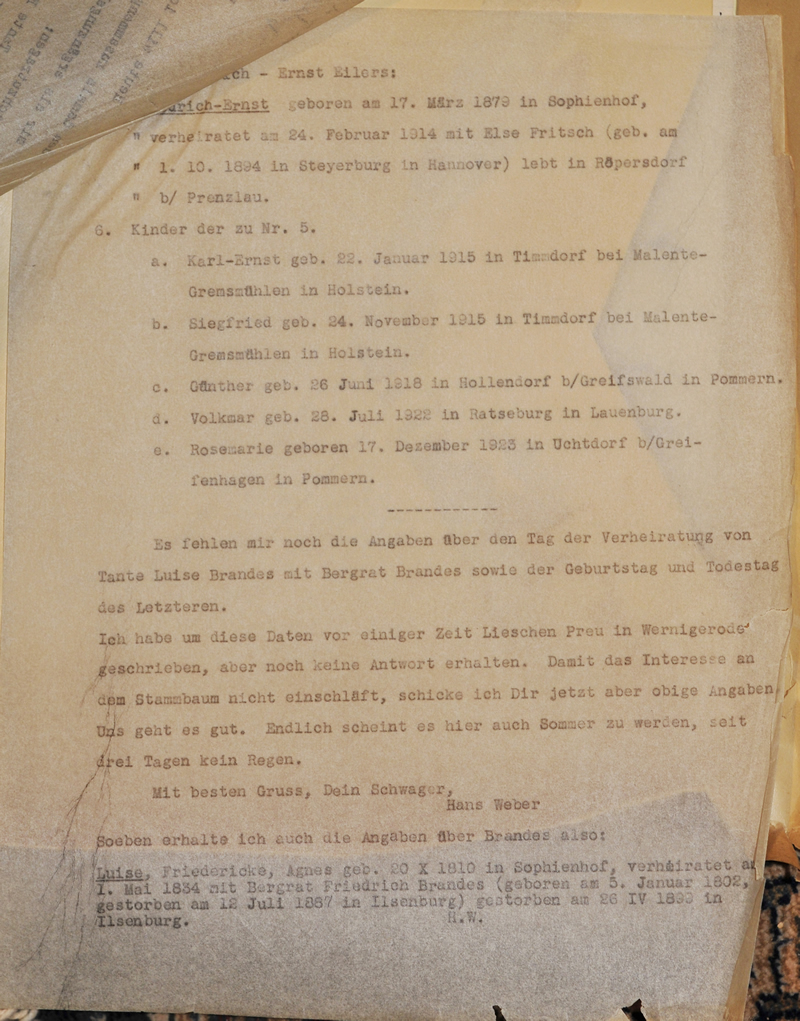
Wurlitzer-Eilers Family photos June 1908
This family photo of the Wurlitzer family was taken in Cincinnati, Ohio. Family members in the legend below the photo are described from the point of view of the Eilers children (Marguerite, Fritz, and Farny). Hence, “Father” is Karl Eilers, top left.
Back Row: Karl Eilers, Howard Wurlitzer, Farny Wurlitzer, Rudolph Wurlitzer, Jr.;
Next Row: Raimund Billing Wurlitzer, Helene (Billing) Wurlitzer, Leonie (Wurlitzer) Eilers (on lap Natalie “Patsy” Wurlitzer), Rudolph Wurlitzer, Leonie (Farny) Wurlitzer, Sylvia (Wurlitzer) (Wienberg) Farny (Alice Farny on lap), Marie Wurlitzer (Cyril Farny on lap);
Front Row: Fritz Eilers, Farny Eilers, Marguerite Eilers, Eugene Wurlitzer, Rembert Rudolph Wurlitzer, Louise Henriette Wurlitzer, Valeska Helene Wurlitzer, Marianne Leonie Wurlitzer, Janet Wurlitzer.

Other photos from the same period:
